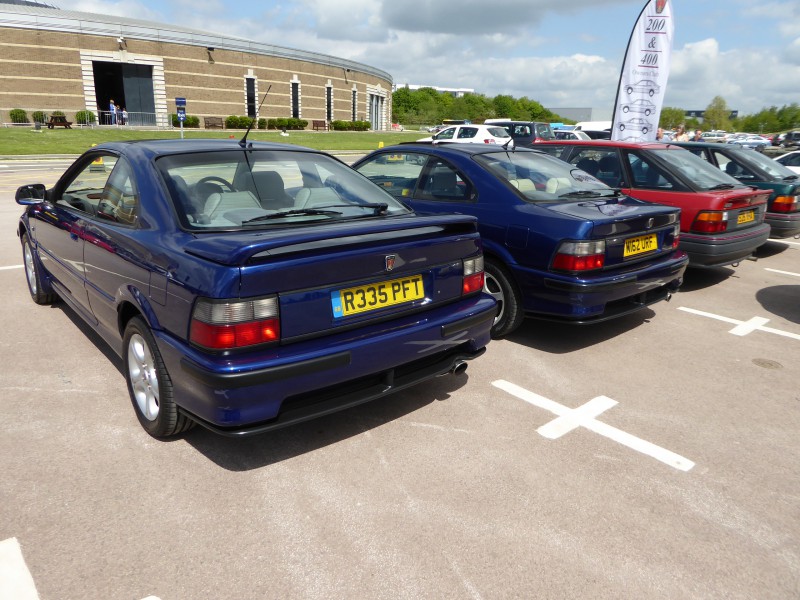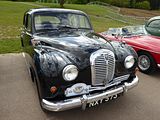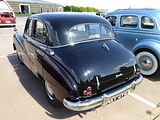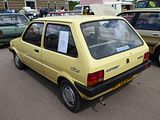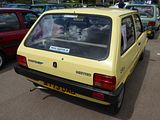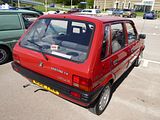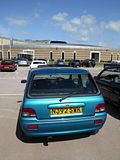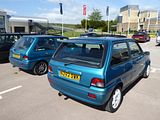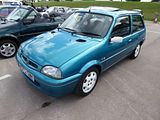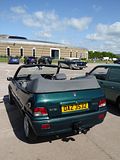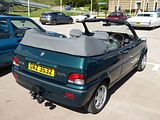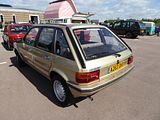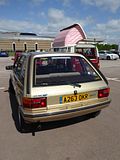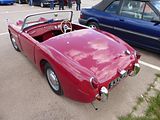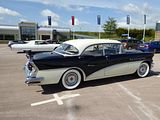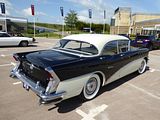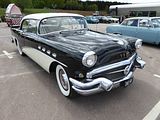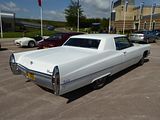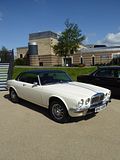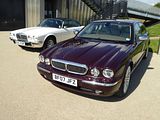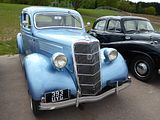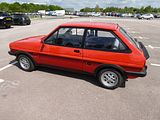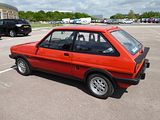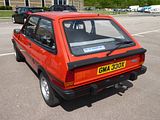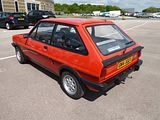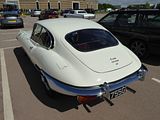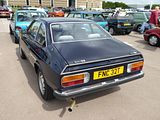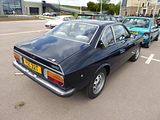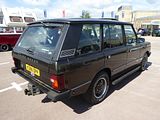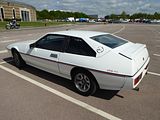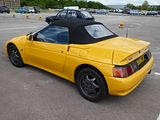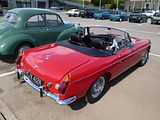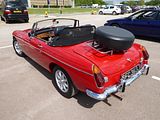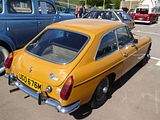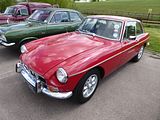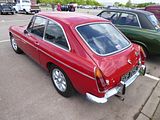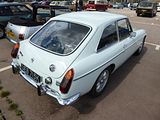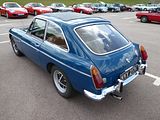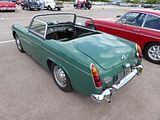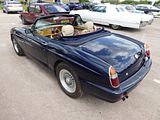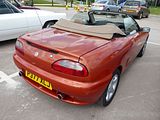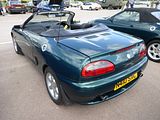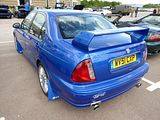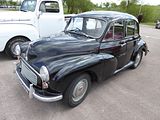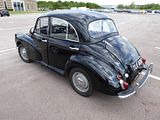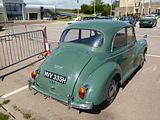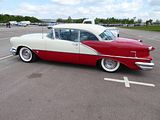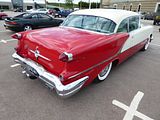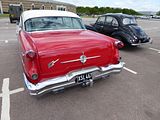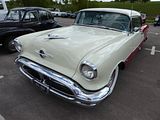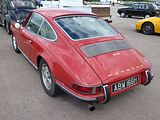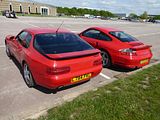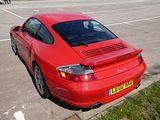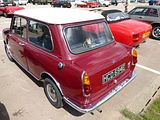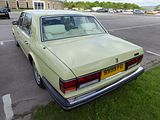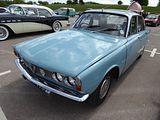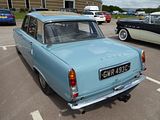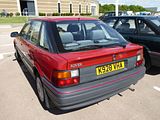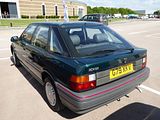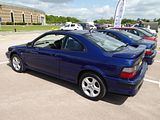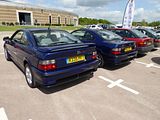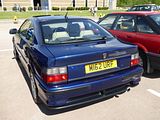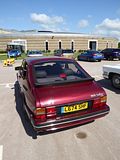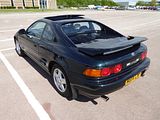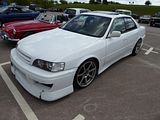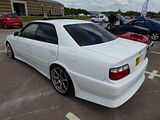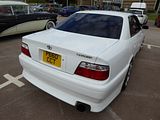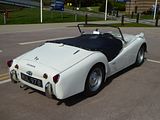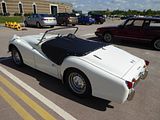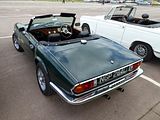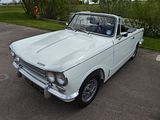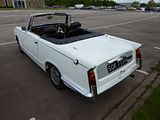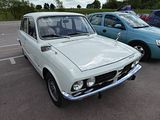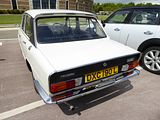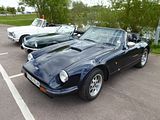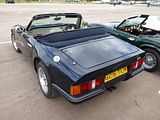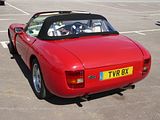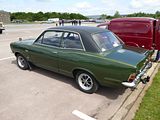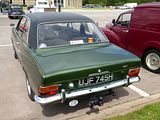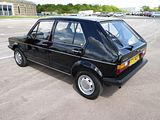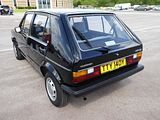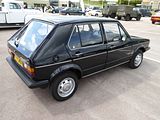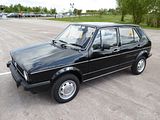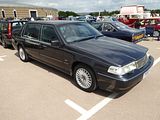As is the case for most weekends of the Events Season, there were plenty of possibilities for the middle of May, and it was hard to choose where I should go. Three events caught my eye, all of them promising an eclectic mix of cars, as their titles suggested that this was exactly what the organisers had in mind. Although it was tempting to make what would have been my first visit to the slopes of Prescott Hill, in Gloucestershire for an event that is organised by the local Rotary Club rather than the venue itself, or indeed to try something hosted by the Classic Car Hire company at their premises near Redditch, in the end I opted for a visit to Gaydon, and their Spring Classic event, something which I have attended before, the last time being in 2013. I knew then that there would be a mix of singleton car entries and some clearly co-ordinated through Owners Clubs. With a sunny start and dry in the forecast, I was optimistic for a bumper turn out. Although there were plenty of nice vehicles to look at, the overall attendance fell some way short of filling the allocated space. I left around lunchtime, having seen everything on site, and with tasks waiting for me at home, so here are the cars which were there during my visit.
AUSTIN
Oldest Austin present was an A40 Somerset, the family car that was a rival to the Morris Oxford and Hillman Minx in the early 1950s. Launched in 1952, as a replacement for the A40 Devon and Dorset, this car which was only made until 1954 looked bigger than its predecessor, though that was largely an illusion of the new appearance which was somewhat “Transatlantic” in style with flowing lines, intended to increase the car’s appeal to export markets. The Somerset bore a close resemblance with the larger Austin A70 Hereford, and telling the two apart at glance is no easier than some of today’s cars where people think that the same styling went under the “reduce” or “enlarge” buttons! The Somerset shared a number of components with its earlier sibling which included a similar 1.2 litre straight-4 pushrod B series engine, but updated to produce 42 hp, compared to the Devon’s 40 hp, giving the car a top speed of 69 mph. Stopping it was done with hydraulic brakes. The Austin A40 Somerset’s reputation for being somewhat slow and lumbering to drive is not wholly deserved. The vehicle had to endure poor quality petrol supplies and in consequence had retarded ignition settings to tolerate the low octane rating of this poor fuel grade to avoid the ‘pinking’ condition that was well known in those times. In fact BMC later produced a kit to improve the performance and fuel consumption of these cars once premium fuel supplies resumed under the popular petrol brands. This kit comprised a replacement distributor and an optional head gasket for the cylinder head that was thinner and therefore raised the compression slightly from the standard 7.2:1. An Autocar magazine road test published 18 April 1952 achieved a maximum of 66 mph and a 0-60 mph acceleration of 36.6 seconds whereas the example registered new in February 1954 and given a Used Car Test published in the Autocar series dated 8 April 1960 returned a 0-60 mph time of just 27.9 seconds. The standing quarter mile was down from 24.4 secs to 23.2 secs a marked improvement on the former result taken in 1952 and directly comparable with the Mini 850 launched in 1959, that was considered to be fairly brisk then. There were two close fitting front seats which could be arranged as a bench seat, with space freed up by virtue of the four speed column mounted gear change. The Somerset was initially offered only as a 4-door saloon, with a 3-passenger 2-door convertible, of the same body shape, introduced in late 1952. The body for the convertible was made by Carbodies of Coventry and the model was marketed as the Austin A40 Somerset Coupé. The convertible differed from the saloon in having separate front seats that folded forward to give access to the rear. The Austin Motor Company in 1953 made a “special” version of around 500 Somerset saloons with a more powerful engine, different interior appointments and two-tone paintwork. The Austin Somerset Special had a top speed of 74 mph. Over 173,000 were sold before the Somerset was replaced by the A40 Cambridge in 1954. 7243 of them were convertibles.
There were a number of Metro and later Rover 100 cars here thanks to a concerted effort by the Owners Club. Oldest example present was a 1.0 City dating from 1984. The City had been introduced as a cheaper model at the foot of the range, and it was basic with a capital B, lacking features such as a passenger door mirror, radio, clock, parcel shelf and reversing lights, which allowed it to be sold for £3496.23. This particular car was found by the current owner a couple of years ago, with just 25,000 miles on the clock, as it had been stored away in a garage after the passing of its elderly owner, and it is gradually being restored to factory fresh condition. Joining it was a 1987 1,3 City X which was nothing like as spartan. By this time, Austin-Rover had introduced a five door model and upgraded the equipment levels on all models, in an effort to compete with a strong lineup of competitors.
Of course what they really needed was a new engine and 5 speed gearbox, and this finally arrived in May 1990 with the launch of a thoroughly revamped car, now branded Rover Metro. With peppy K Series engines and much improved fit and finish, the car shot straight back to the top of the class, even though the basic design was nearly 10 years old at the time. With no money to fund the development of a replacement, though, as the 1990s wore on, the car looked increasingly dated and it was quite a surprise that the dealers managed to keep selling as many of what became the Rover 100 as they did right up the model’s demise at the end of 1997. New trims, extra features and an array of limited edition models all helped, of course. As well as the Rover Metro 1.4Li that was here were a duo of Rover 100 models, both painted in the rather nice Kingfisher Blue colour.
Also present was a Metro 114GTa Cabrio. The open-topped version of the Metro was launched in MPi GTi from at the Berlin Motor Show in the Autumn of 1992, as part of Rover Group’s early 90s plan to fill as many market niches as possible and one was one of a trio of Cabriolets, the others being the better known MG RV8 and the Mini Cabrio both of which followed soon after the Metro, at the Birmingham Motor Show that October. The open topped Metro was initially slated for availability in ‘early 1993’, but that dropped back to 1994 (now said to be in SLi form) because of delays. Part of the reason for this was that a key supplier, LAMM, which had done so much work on the open Mini and the Metro went bust, which made it necessary to find another supplier. Tickford was commissioned to refine the original work undertaken, and ready the cars for production. The Metro Cabriolet was initially a Rover Special Products (RSP) car, built at Longbridge, on the same basis as the Mini Cabriolet – slotted in and out of the regular model production process wherever possible, so that it benefited from proper priming and paint processes. Engineering-wise, the Cabriolet version was rather interesting. It was based upon the platform of the five-door model, and that would explain why the petrol cap was under a flap and not the simpler disc-style exposed item as used in the three-door hatchback. To strengthen the bodyshell, the lateral box sections under the front seats were widened, and that compromised rear seat legroom, as the footwells were smaller in the back. Despite the fashionable notion that the Metro/100 bodyshell lacks stiffness, this is clearly not the case as no additional metal was added to the bulk-head when in the process of becoming a cabriolet. Also, the A-pillars are standard, with a modified section forming the top windscreen edge to create the lip for the leading edge of the roof to sit against. However, there were plenty of structural modifications to the rear of the car. A double-skinned ‘parcel shelf’, specially shaped inside to bend the rear window when retracted, and three box sections to create lateral strength were added. These are not dissimilar to the roll-bar/head-restraint device on the MINI convertibles – except they’re upside down and hidden from view. This left a half-width luggage passage into the rear passenger space. The bespoke one-piece back seat jack-knifed just as in the standard car. The boot lid opened upwards on special parallelogram hinges and was a chopped-down version of the original. The fully-lined roof was designed specially and caused many problems and delays, with the original supplier having to be replaced. Consequently Rover Metro/100s have black roofs whereas facelift (post-1995) 100s have Grey hoods. All grey tops were electrically operated through one hydraulic motor feeding two raising arms. The Vynide rear window zipped open as on the MGF and TF and 200 Cabriolet, and the rear quarter light windows retract asymmetrically into the body leaving a crescent of glass visible. Strangely, though, electric front window operation was even not an option. By the time the car came to market, it was expensive. Too expensive, and the cars struggled to find buyers. To get round it, Rover found an interesting solution. Boatloads of them were shipped to Jersey, where the cars were used as rental machines, accruing very small mileages, and then when they were returned to the mainland, they could be sold as demonstrators, but without the need for VAT, as they had already been registered and hence were technically second hand. Initially, the car was supposed to be available in 1.4 Cabriolet and 1.4 16v Cabriolet form in the UK market, and 1.4 8v only in mainland Europe. A 1.1 for Europe was mooted, and a few were sold in the Netherlands. Electric operation of the roof was supposed to be an option initially, possibly standard on the 16v, and only became standard with on the later grey-roof cars. The Cabriolet 8v was built to ‘S’ specification with a Renaissance fabric interior, and the 16v was a Metro GTi Cabriolet in all but name. No-one really knows how many were officially built, but it certainly was not a lot. It is thought that there could well have been only a couple of hundred of the pre-1995 Metro/100 built, with anything between 500 and 2000 of the later cars finding new homes. They were available only on back-order from Rover, and the company kept pretty quiet about the car There certainly are not many left. This 114GTa. certainly started out its life in Jersey.
There were also a couple of examples of the Metro’s larger brother, the Maestro. The duo here, one of which was parked in the Disabled area and not officially part of hte event came from the first and last few months of production. The early car was a 1.3 HLE. This was intended to be the economy-optimised version of the car, but as it was fitted with the same 3+E gearbox from VW as went into the unlamented Formel E VWs of the era, rather than a proper 5 speed unit, and gearing that made it rather less lively to drive than the regular 1275cc A+ Series engined 1.3 L and later City models. An economy gauge took the place of the ashtray and there were aerodynamic aids around the rear tailgate. Like all Maestro models, things got a better over time, when the Montego dashboard went in the car, and the more potent ones got the S Series engine in lieu of the R Series unit, and equipment levels steadily improved, but the damaged reputation from the early cars meant that the model never really achieved its full potential. Late in its life, a diesel unit, the 2 litre Perkins direct injection unit, which was efficient if rather noisy, was put under the bonnet of the car, and with the Maestro now positioned as a roomy and cheap family car, it made some sense.
AUSTIN HEALEY
Slightly surprisingly, perhaps, there were no examples of the Big Healey here, leaving this “Frog Eyed” Sprite as the sole representative of this popular marque. The Sprite was announced to the press in Monte Carlo by the British Motor Corporation on 20 May 1958, just before that year’s Monaco Grand Prix. It was intended to be a low-cost model that “a chap could keep in his bike shed”, yet be the successor to the sporting versions of the pre-war Austin Seven. The Sprite was designed by the Donald Healey Motor Company, with production being undertaken at the MG factory at Abingdon. It first went on sale at a price of £669, using a tuned version of the Austin A-Series engine and as many other components from existing cars as possible to keep costs down. It was produced for a little over 3 years before being replaced by a Mark 2 version, which was then joined by a badge-engineered MG version, the Midget, reviving a model name used by MG from the late 1920s through to the mid 1950s. Enthusiasts often refer to Sprites and the later Midgets collectively as “Spridgets.” The first Sprite quickly became affectionately known as the “frogeye” in the UK and the “bugeye” in the US, because its headlights were prominently mounted on top of the bonnet, inboard of the front wings. The car’s designers had intended that the headlights could be retracted, with the lenses facing skyward when not in use; a similar arrangement was used many years later on the Porsche 928. But cost cutting by BMC led to the flip-up mechanism being deleted, therefore the headlights were simply fixed in a permanently upright position, giving the car its most distinctive feature. The body was styled by Gerry Coker, with subsequent alterations by Les Ireland following Coker’s emigration to the US in 1957. The car’s distinctive frontal styling bore a strong resemblance to the defunct American 1951 Crosley Super Sport. The problem of providing a rigid structure to an open-topped sports car was resolved by Barry Bilbie, Healey’s chassis designer, who adapted the idea provided by the Jaguar D-type, with rear suspension forces routed through the bodyshell’s floor pan. The Sprite’s chassis design was the world’s first volume-production sports car to use unitary construction, where the sheet metal body panels (apart from the bonnet) take many of the structural stresses. The original metal gauge (thickness of steel) of the rear structure specified by Bilbie was reduced by the Austin Design Office during prototype build, however during testing at MIRA (Motor Industry Research Association) distortion and deformation of the rear structure occurred and the original specification was reinstated. The two front chassis legs projecting forward from the passenger compartment mean the shell is not a full monocoque. The front sheet-metal assembly, including the bonnet (hood) and wings, was a one-piece unit, hinged from the back, that swung up to allow access to the engine compartment. The 43 bhp, 948 cc OHV engine (coded 9CC) was derived from the Austin A35 and Morris Minor 1000 models, also BMC products, but upgraded with twin 11⁄8 inch SU carburettors which gave it 43 hp at 5200 rpm and 52 lb/ft at 3300 rpm. When tested by “The Motor” magazine in 1958. It had a top speed of 82.9 mph and could accelerate from 0-60 mph in 20.5 seconds. Fuel consumption of 43 mpg was recorded. The rack and pinion steering was derived from the Morris Minor 1000 and the front suspension from the Austin A35. The front suspension was a coil spring and wishbone arrangement, with the arm of the Armstrong lever shock absorber serving as the top suspension link. The rear axle was both located and sprung by quarter-elliptic leaf springs, again with lever-arm shock absorbers and top links. There were no exterior door handles; the driver and passenger were required to reach inside to open the door. There was also no boot lid, owing to the need to retain as much structural integrity as possible, and access to the spare wheel and luggage compartment was achieved by tilting the seat-backs forward and reaching under the rear deck, a process likened to potholing by many owners, but which resulted in a large space available to store soft baggage. The BMC Competition Department entered Austin Healey Sprites in major international races and rallies, their first major success coming when John Sprinzel and Willy Cave won their class on the 1958 Alpine Rally. Private competitors also competed with much success in Sprites. Because of its affordability and practicality, the Austin Healey Sprite was developed into a formidable competition car, assuming many variants by John Sprinzel, Speedwell and WSM. The Sebring Sprite became the most iconic of the racing breed of Austin Healey Sprites. Many owners use their Austin Healey Sprites in competition today, fifty years after its introduction. 48,987 “frogeye” Sprites were made and the car remains popular to this day.
BUICK
One of a trio of fabulous classic American machines from the 1950s and 1960s was this 1956 Century. Buick had first used the Century name in 1936, using it as some Buick execs had learned that – apparently – the British used to refer to travelling at 100 mph as “doing the century”, and as their new model could achieve that speed, the name stuck. It was applied to Buick’s mid range model until 1942. In 1954, Buick reintroduced the Century name, using the same formula of mating the smaller, lighter Buick Special body to its largest and most powerful 322 cubic inch V8 engine with the intent of giving Buick a performance vehicle. Included in the model lineup during this period was a station wagon model, a body style that had been unavailable during the Century’s first production period. Introduced in the middle of the 1955 model year the 4-door Buick Century Riviera along with the 4-door Special Riviera and the 4-door Oldsmobile 98 Holiday and 4-door 88 Holiday, were the first 4-door hardtops ever produced. This was the first time “VentiPorts” appeared on the Century, a carryover from the Buick Roadmaster. In 1955, the California Highway Patrol placed a large fleet order for Century 2-door sedans, a body style unavailable to the general public. It combined the Special 2-door sedan body shell with Century powertrain and trim. Broderick Crawford was shown driving a 2-door Century sedan during the first season of his popular syndicated TV series “Highway Patrol”. Power brakes were optional. Tubeless tyres were new. The Century remained Buick’s performance line, with engine power rising from 200 bhp (SAE) in 1954, to 236 in 1955, to 255 in 1956, and topping out at 300 from a bored-out 364 cu in (6.0 litre) engine in 1957–58, the last model years for the full sized Century line. In 1956 the Century’s base price was $2,963. Power windows were standard in the convertible. A padded safety dash became optional. Because the Century was considered the senior “small Buick”, the model received GM’s only hardtop station wagon, the Century Caballero, from 1957 through 1958. The Caballero proved expensive to manufacture and unpopular with customers (only 14,642 produced for both model years), so GM did not bring it back for 1959. For 1959, Buick renamed the Century the Invicta.
CADILLAC
A few years its junior was an even larger American car, this gargantuan Coupe de Ville. De Ville was originally just a trim level, but it soon became a model in its own right, which stayed in the range right up to 2005 when the name was replaced by the DTS. The example seen here is from the series that was built between 1965 and 1970. De Ville denoted Cadillac’s mainstream model, falling between the Calais (which had replaced the Series 62) and the Sixty Special and Eldorado. The De Ville was redesigned for 1965 but rode on the same 129.5-inch (3,290 mm) wheelbase. Tailfins were canted slightly downward, and sharp, distinct body lines replaced the rounded look. Also new were a straight rear bumper and vertical lamp clusters. The headlight pairs switched from horizontal to vertical, thus permitting a wider grille. Curved frameless side windows appeared, and convertibles acquired tempered glass backlights. New standard features included lamps for luggage, glove and rear passenger compartments and front and rear safety belts. Power was still supplied by the 340 horsepower 429 cu in (7,030 cc) V8, which would be replaced by the 472 cu in (7,730 cc) for 1968. Perimeter frame construction allowed repositioning the engine six inches forward in the frame, thus lowering the transmission hump and increasing interior room. Pillared sedans appeared on the De Ville series for the first time, while six-window hardtop sedans were dropped. A padded vinyl roof was a $121 extra-cost option on the hardtop model. All four De Ville models had small “Tiffany-like” script nameplates on the ends of their rear fenders just above the chrome side moulding. In 1966 changes included a somewhat coarser mesh for the radiator grille insert, which was now divided by a thick, bright metal horizontal centre bar housing rectangular parking lamps at the outer ends. Separate rectangular side marker lamps replaced the integral grille extension designs. There was generally less chrome on all Cadillac models this year. De Ville scripts were still above the rear tip of the horizontal body rub moldings. Cadillac crests and V-shaped mouldings, front and rear, were identifiers. Cadillac “firsts” this season included variable ratio steering and optional front seats with carbon cloth heating pads built into the cushions and seatbacks. Comfort and convenience innovations were headrests, reclining seats and an AM/FM stereo system. Automatic level control was available. Engineering improvements made to the perimeter frame increased ride and handling ease. Newly designed piston and oil rings and a new engine mounting system and patented quiet exhaust were used. The 1967 De Villes were extensively restyled. Prominent styling features were given a powerful frontal appearance with forward-leaning front end, long, sculptured body lines, and redefined rear fenders that had more than just a hint of tail fins in them. The full-width, forward-thrusted “eggcrate” grille was flanked by dual stacked headlights for the third consecutive year. The squarer cornered grille insert had blades that seemed to emphasise its vertical members and it appeared both above the bumper and through a horizontal slot cut into it. Rectangular parking lamps were built into the outer edges of the grille. Rear end styling revisions were highlighted by metal divided tail lamps and a painted lower bumper section. Coupe de Villes got a new roofline, inspired by the Florentine show car created for the 1964 New York World’s Fair, that gave rear seat passengers added privacy. As on that show car, the quarter window glass retracted rearward into a sail panel. Minor trim variations and slightly richer interiors separated De Ville from Calais. Tiffany style chrome signature scripts were again found above the body side moulding on the rear fenders. New standard De Ville features included non-glare rear-view mirror, electric clock, Automatic Climate Controls, padded dashboard, Hazard Warning system, outboard seatbelt retractors and rear cigarette lighters in all styles. A slide-out fuse box and safety front seat back lock for two-door models were additional Cadillac advances for the 1967 model year. Technical improvements included a revised engine valve train, different carburettor, Mylar printed circuit instrument panel, re-tuned body mounts, and a new engine fan with clutch for quieter operation. In 1968 grilles had an insert with finer mesh and step down outer section which held the rectangular parking lights just a little higher than before. Rear end styling was modestly altered with the deck lid having more of a rake. The most obvious change was an 8.5-inch-longer bonnet designed to accommodate recessed windshield wiper-washers, which now came with three speeds standard. Of 20 exterior paint colour combinations, 14 were totally new. On the inside enriched appointments included molded inner door panels with illuminated reflectors and a selection of 147 upholstery combinations, 76 in cloth, 67 in leather and four in vinyl. New standard features included a Light Group, a Mirror Group, a trip odometer and an ignition key warning buzzer. The De Ville also gained a new 472 cu in (7,730 cc) V8 engine rated at 375 hp (SAE gross). 1968 was also the last year for the “stacked” dual headlights, which were replaced with side-by-side dual headlights in 1969. This was also the last year for vent windows. Side marker lights in the rear bumper as well as front fender were also added. Side mirror changed from a round to rectangular shape. Also of note front disc brakes were available starting in 1968. In 1969 De Ville was restyled in the Eldorado image. An Eldorado-like front fender treatment evolved and helped to emphasise a stronger horizontal design line. Rear quarters were extended to give the car a longer look. There was an all new grille with dual horizontal headlamps positioned in the outboard step down areas of the grille. The hood was again extended, a total of 2.5 inches to add the impression of extra length. The roofline was squarer and the rear deck and bumper more sculptured. A new ventilation system eliminated the need for vent windows, which provided a longer sleeker look and improved visibility. New standard features included front and rear (except on convertibles) centre seat armrests. In 1970 a facelift included a grille with 13 vertical blades set against a delicately cross-hatched rectangular opening. The bright metal headlamp surrounds were bordered with body colour to give it a more refined look. Narrow vertical “vee” tail lights were seen again, but now had additional smaller V-shaped bottom lenses pointing downward below the bumper. Wheel discs and winged crest fender tip emblems were new. Exterior distinctions came from a De Ville script above the rear end of the belt moulding and from the use of long rectangular back up light lenses set into the lower bumper as opposed to the smaller square lens used on the Calais. A new feature was a body colour border around the edge of the vinyl top covering, when this option was ordered. 1970 was the last model year for pillared sedans until hardtops were permanently dropped in 1977. It was also the last year the De Ville ever offered the convertible body style. A total of 181,719 De Villes were sold, accounting for 76% of all Cadillacs. Never again would Cadillac sales be dominated to such a degree by a single model.
DAIMLER
The SP250 “Dart” was quite unlike any previous Daimler model, the marque having a history of producing a series of luxurious saloon and open topped models. But by the mid 1950s, the once proud Coventry marque was in trouble, with a range of cars which were expensive and just not selling. New models were seen as a potential way of changing things around, so shortly after being appointed Managing Director of BSA’s Automotive Division in 1956, Edward Turner was asked to design a saloon car powered by a new V8 engine. The engine drawings were finalised by March 1958 but the saloon prototype, project number DN250, was not available for examination by the committee formed in 1958 to report on the feasibility of the V8 cars. The committee’s evaluation centred on the prototypes being tested at the time, which were for the SP250 sports car project. according to the feasibility study conducted by the committee, the SP250 would generate a profit of more than £700,000 based on a projection of 1,500 cars being sold in the first year of production and 3,000 cars per year for the second and third years of production. Two-thirds of the sales of the car were expected to be in the United States. The study also determined that the body should be made from fibreglass, with shorter time to the beginning of production, tooling costs of £16,000 as opposed to £120,000 for steel bodies, and lower cost to change the styling. That meant that the car was able to be launched at the 1959 New York Show, christened the Daimler Dart. Chrysler, whose Dodge division owned the trademark for the “Dart” model name, ordered Daimler to change the name under threat of legal action. With little time to come up with a new name, Daimler used the project number, SP250, as the model number. The car certainly looked quite unlike previous Daimlers, but whether that was a good thing is less clear as the SP250 won “The Ugliest Car” via vote at that 1959 show. That was not the only problem with the car, either. The original version, later called the A-spec, could reach a speed of 120 mph, but the chassis, a “14-gauge ladder frame with cruciform bracing” based on the Triumph TR3, flexed so much that doors occasionally came open, marring its reputation. The car featured the smaller of the two hemi-head V8 engines which Edward Turner had designed. 2547cc in capacity, it was a V8, iron block, OHV unit, with a single central camshaft operated valves through short pushrods with double heavy-duty valve springs, aluminium alloy hemispherical cylinder heads, and twin SU carburettors which meant it put out 140 bhp.The manual gearbox, the first of the type used by Daimler since they started using the pre-selector type across their range in the 1930s,, was reverse-engineered from the Standard gearbox used in the Triumph TR3A. Early examples of the car were not particularly reliable. Sales were slow, initially, and Daimlers problems were compounded when, not long after they had been acquired by Jaguar, an in-house rival in the form of the E Type arrived on the scene. New bosses at Jaguar did not kill off the SP250, though, but they were immediately concerned about the chassis flex. They brought out the B-spec. version with extra outriggers on the chassis and a strengthening hoop between the A-posts. There were also other detail improvements, including an adjustable steering column. Bumpers had originally been an optional extra. With the basic specification not including full bumpers, the A-spec. cars have two short, chromium-plated ‘whiskers’ on the body on either side of the front grille and two short, vertical bumpers, or “overriders” at the rear, which were not included if the rear bumper was optioned. B-spec. and the later C-spec. cars do not have the ‘whiskers’ that A-spec. have and some do not have the optional front bumper, so there is very little front protection for these cars. A planned Coupe version of the car, the DP250 never got beyond the prototype phase, and Ogle Design’s proposal for a Coupe version was not taken up, the styling for that concept ending up forming the Reliant Scimitar GT. The SP250 ended production in 1964. Just 2,654 SP250s were produced in five years of production, far short of the projection of 3,000 per year by the second year of production. Jaguar did built a prototype replacement under project number SP252 with a neater body style but decided not to proceed with production, as they figured that the cost to build the SP252 would have been greater than that of Jaguar’s popular and more expensive E-Type, thereby creating internal competition from a product with no practical profit margin and with uncertain market acceptance. The 2½ litre V8 engine used in the SP250 was used by Jaguar to power the smaller saloon Daimler had wanted from the start. This was basically a Jaguar Mark 2 with the V8 engine from the SP250 modified to fit in the Mark 2 engine bay and revised interior, trim, and suspension settings. Sold between 1962 and 1967 as the Daimler 2½-litre V8 and from 1967 to 1969 as the Daimler V8-250, the Daimler car with the highest production figures. These days, surviving SP250s are viewed rather more positively than they were when new, and a certain Quentin Willson, who has owned one for many years, is particularly positive about the car’s merits.
This duo of cars were not officially part of the event, as they belong to the Jaguar/Daimler collection that is now on show on site, but as they were both classic models, I felt that they belonged in this report. Older of the pair was a Sovereign Coupe, the short-lived 2 door version of the Series 2 XJ Series and related Daimler model, made only between 1975 and 1977 and the more recent car was a Super Eight from 2007. This was the very last model to bear the Daimler badging. Starting off as the Super V8, which debuted in the 2003 model year in the new X350 body style, this was essentially a long-wheelbase, supercharged XJ8 with the more luxurious Vanden Plas, or Daimler interior. Its primary competitor was the Mercedes-Benz S55 AMG. A distinctive wire mesh grille and chrome-finished side mirrors set the Super V8 and the XJR apart from the less expensive XJ saloons. In 2005, the Super V8 model was replaced by the Daimler Super Eight in all markets other than North America. The Daimler Super Eight was essentially the same car, but with the addition of a different grille, boxwood inlays in the wood veneer and several other interior luxuries as standard. Daimler’s US equivalent was no longer known as the Vanden Plas, but the Super V8. The Vanden Plas name was used on models that would be known as Sovereign elsewhere. For 2007, the premium model was the reintroduced Jaguar Sovereign when the Super V8 and Daimler versions were dropped.
FORD
Oldest Ford here was a 1935 Ford V8 Model 48, an update on Ford’s V8-powered Model 40A, the company’s main product. Introduced in 1935, the Model 48 was given a cosmetic refresh annually, begetting the 1937 Ford before being thoroughly redesigned for 1941. The 1935 Ford’s combination of price, practicality, and looks vaulted the company ahead of rival Chevrolet for the sales crown that year, with 820,000 sold. The four-cylinder Model A engine was no longer offered, leaving just the 221 CID (3.6 litre) V8 to power every Ford car and truck. The transverse leaf spring suspension remained, but the front spring was relocated ahead of the axle to allow more interior volume. The body was lowered and new “Center-Poise” seating improved comfort. Visually, the 1935 Ford was much more modern with the grille pushed forward and made more prominent by de-emphasised and more-integrated wings. A major advance was a true integrated trunk on “trunkback” sedans, though the traditional “flatback” was also offered. Outdated body styles like the Victoria were also deleted for the year. Two trim lines were offered, standard and DeLuxe, across a number of body styles including a base roadster, five-window coupe, three-window coupe, Tudor and Fordor sedans in flatback or trunkback versions, a convertible sedan, a woody station wagon, and new Model 51 truck. Rumble seats were optional on coupe model. An oil pressure gauge($4) and two windshield wipers were optional. [If one got the optional radio, it replaced the ash tray. This particular car only came to the UK a couple of years ago. It starred in the recently released movie “Florence Foster Jenkins”, where it was painted yellow, as a New York Taxi. Since then it has been repainted.
Also from Ford’s US catalogue was this F100 Pickup. Ford first coined the F Series nomenclature in 1948 with a new range of pickups which were purposed designed as opposed to being converted versions of their regular passenger cars. A second generation was launched in 1953, running for 3 years. The 1953 redesign had a more integrated look and was also when the pickups obtained their widely familiar names: The F-1 now became the F-100, the F-2 and F-3 now became the F-250, and the F-4 now became the 1-ton F-350. Optional interior amenities were new, including a dome light, lighter, arm rests, sun visors and a radio. On March 13, 1953, the Ford-O-Matic automatic transmission became an option. The 1953 F-100 was the last year for the flathead engine in the US. Models in Canada, however, (Mercury M-Series), retained the flathead. 1953-54 saw the introduction of the new 239 CID overhead valve Y-block V8, dubbed “Power King.” The six-cylinder engine’s displacement was also increased from 215 to 223 CID and power steering was introduced as an option. In 1954 the 239 Y-block was replaced with the 279 and 317.
The only European Ford here was a splendid early Fiesta XR2. This was the first truly sporting Fiesta, as the earlier S badged cars were mechanically the same as the other models in the range and even the Supersport was offered in Europe for the 1980 model year, used the regular 1.3 litre Kent Crossflow engine. It was well enough received, though, to convince Ford to introduce in October 1981 their second XR-badged model, following the October 1980 launch of the Escort XR3. The XR2 featured a 90 bhp 1.6 litre engine and is easily identified from the black plastic trim which was added to the exterior and interior. The small square headlights were replaced with larger circular ones resulting in the front indicators being moved into the bumper to accommodate the change. With a quoted performance of 0–60 mph in 9.3 seconds and a 105 mph top speed, the XR2 hot hatch became a cult car beloved of boy racers throughout the 1980s meaning that very few have survived. This one was in fabulous condition.
JAGUAR
There were just two Jaguars among the cars assembled, a Series 2 E Type Coupe 4.2 and an XJS-C. The XJS-C was the first open-topped XJS, appearing in the autumn of 1983, alongside the new AJ6 6 cylinder engine. When the XJ-S had been designed, it was assumed that US regulations would outlaw convertible models, and as this would be the largest market for the car, Jaguar had proceeded just with a closed Coupe. However, it turned out not just that open cars were still permitted but that there was demand for them, which led to the challenge of trying to create an open car from one which was never intended or engineered to be so. The XJS-C was not a full convertible, but more of a Targa, with two removable roof panels and a folding rear section. It was not particularly popular. The fully open Convertible model which was launched in 1989 was far more successful, so XJS-Cs are a rare sighting.
LANCIA
The Coupe was the second model in the Beta range to appear, being launched in late 1973, although due to the fuel crisis, it did not become available to the public until early 1974, though the UK had to wait a further year before being able to buy one. A stylish 2 + 2 model with a 93″ wheelbase, the bodywork which looked completely from the Beta Berlina whose underpinnings were used, was developed inhouse by a Lancia team led by Aldo Castagno, with Pietro Castagnero acting as styling consultant. Castagnero had also styled the Beta’s predecessor, the Lancia Fulvia saloon and coupé. It was launched with 1.6 and 1.8 engines. New 1.6 and 2.0 engines replaced the original units in late 1975 and these were followed by a 1.3 in early 1976 when production of the Fulvia Coupe S3 ceased. In 1978 automatic transmission and power steering became available. In 1981 the car received a minor facelift and at the same time the 2.0 became available with fuel Bosch electronic fuel injection. In 1983 a 2.0 VX supercharged engine became available with an output of 135 bhp. A total of 111,801 of them were built and far more survive than the Berlina version. Seen here was a 1300 Coupe.
LAND ROVER
First generation Range Rover models have become highly collectible, but at present all the interest are on the very earliest models. Although back in 1970 the car seemed quite luxurious, that was nothing compared to how the car developed in the 1980s, when Land Rover realised that there was a sizeable and growing market for commodious luxury off-roaders. The example seen here is the apogee of the range, the Vogue LSE, which sat at the top of the range, before its replacement by the P38 cars in 1994.
LOTUS
The Type 89 Lotus Excel, built from 1982 to 1992, was a development of the earlier Lotus Eclat, which itself was based on the Type 75 Elite. Although a promising design, the Elite and Eclat had suffered from numerous quality control issues which were difficult for owners to accept given the price of the cars. The Excel was a concerted effort to address these, and it stood every chance of so doing, as it took advantage of the relationship with Toyota. This had started when Toyota engaged Lotus to assist with engineering work on the Supra. During this period, Toyota then became a major shareholder in Lotus. Part of the deal between the two included the use of many Toyota mechanical components in Lotus’ cars. The original Excel (aka the Eclat Excel) used the W58 manual transmission, driveshafts, rear differential, 14×7 in alloy wheels, and door handles from the Supra Mk II, which was made from 1982 to 1986. The engine was the familiar all-aluminium, DOHC 2.2 litre Lotus 912 Slant Four which was also used in the Lotus Esprit S3. During its lifetime, the Excel received two major upgrades. With the introduction of the Excel SE which had a 180 bhp engine vs the standard 160 bhp car in October 1985, the bumpers, wing and interior was changed, including a new dashboard. In October 1986 the Excel SA with automatic gearbox was introduced. Further facelifts in 1989 saw Citroën-derived mirrors, as featured on the Esprit, and 15 inch OZ alloy wheels to a similar pattern as the Esprit’s. According to Lotus records, only 1 Excel was manufactured to USA specification. The lack of release in the USA was due to the high emission regulations (which would hinder the car’s performance), and poor sales of the car in Europe.
The other Lotus here was one of the front wheel drive Elan SE Turbo Type M100 cars. Like many specialist produced cars of the era, there was a long wait for this car form when news first broke that it was under development to the actual release of cars people could buy. The M100 Elan story goes back to 1986 and the purchase of Lotus by General Motors which provided the financial backing to develop a new, small, affordable car in the same spirit as the original Elan, the last of which had been built in December 1972. A development prototype, the M90 (later renamed the X100) had been built a few years earlier, using a fibreglass body designed by Oliver Winterbottom and a Toyota-supplied 1.6-litre engine and transmission. Lotus was hoping to sell the car through Toyota dealerships worldwide, badged as a Lotus Toyota, but the project never came to fruition and the prototype was shelved, although Lotus’s collaboration with Toyota had some influence on the design of the Toyota MR2. The idea of a small roadster powered by an outsourced engine remained, however, and in late 1986 Peter Stevens’s design for the Type M100 was approved and work began by Lotus engineers to turn the clay styling buck into a car that could be built. This process was completed in just under three years, a remarkably short time from design to production car. The M100 Elan was conceived as a mass-market car and in particular one that would appeal to US buyers. Consequently, Lotus put an enormous effort (for such a small firm) into testing the car; over a two-year period 19 crash cars and 42 development vehicles were built, logging nearly a million test miles in locations from Arizona to the Arctic. The Elan was driven at racing speeds for 24 hours around the track at Snetterton. Finally each new car was test-driven for around 30 miles at Lotus’s Hethel factory to check for any manufacturing defects before being shipped to dealers. The choice of front-wheel drive is unusual for a sports car, but according to Lotus sales literature, “for a given vehicle weight, power and tyre size, a front wheel drive car was always faster over a given section of road. There were definite advantages in traction and controllability, and drawbacks such as torque steer, bump steer and steering kickback were not insurmountable.” This was the only front-wheel-drive vehicle made by Lotus. Every model made since the M100 Elan, such as the Lotus Elise, has been rear-wheel drive. The M100 Elan’s cornering performance was undeniable (on release the Elan was described by Autocar magazine as “the quickest point to point car available”). Press reaction was not uniformly positive, as some reviewers found the handling too secure and predictable compared to a rear-wheel-drive car. However, the Elan’s rigid chassis minimised roll through the corners and has led to its description as ‘the finest front wheel drive [car] bar none’. Unlike the naturally aspirated version, the turbocharged SE received power steering as standard, as well as tyres with a higher ZR speed rating. The M100 Elan used a 1,588 cc double overhead camshaft (DOHC) 16-valve engine, sourced from the Isuzu Gemini and extensively modified by Lotus (a third generation of this engine was later used in the Isuzu Impulse), which produced 162 hp. 0–60 acceleration time was measured by Autocar and Motor magazine at 6.5 seconds, and a top speed of 137 mph was recorded. Significant differences in the Isuzu-Lotus engine from the original include a new exhaust system, re-routed intake plumbing for better thermodynamic efficiency, improved engine suspension, and major modifications to the engine control unit to improve torque and boost response. Almost all models featured an IHI turbocharger. Two variants were available at launch, the 130 bhp Elan 1.6 (retailing at £17,850) and the 162 bhp Turbo SE (£19,850). Initial sales were disappointing, perhaps because its launch coincided with a major economic recession in the UK and USA, and perhaps also because it coincided with the cheaper Mazda MX-5 which was arguably similar in concept, though the MX-5 was quite intentionally nostalgic and old fashioned (apeing the original Elan), while the M100 was deliberately futuristic, modern and forward looking. The Elan was regarded as a good product in a bad market, but was also very expensive to make (the cost to design and produce the dashboard alone was more than the total cost of the Excel production line), and sales figures were too low to recoup its huge development costs. Altogether 3,855 Elans were built between November 1989 and July 1992, including 129 normally aspirated (non-turbo) cars. 559 of them were sold in the US, featuring a ‘stage 2 body’ which had a different rear boot spoiler arrangement together with a lengthened nose to accommodate a USA-compliant crash structure and airbag, and 16-inch wheels (optional in most markets, standard in the U.S.) instead of 15-inch as on the UK model. A limited edition of 800 Series 2 (S2) M100 Elans was released during the Romano Artioli era (produced June 1994–September 1995) when it was discovered that enough surplus engines were available to make this possible. According to Autocar magazine, the S2 addressed some of the concerns over handling, but power was reduced to 155 bhp and the 0–60 acceleration time increased to 7.5 seconds, due to the legislative requirement to fit a catalytic converter in all markets. The S2s have very similar performance to the USA vehicles, having an identical engine management system calibration and a slightly lower overall vehicle weight.
MG
Launched in October 1962, the MGB was produced for the next 18 years and it went on to become Britain’s best selling sports car and these days it has to be one of the most popular classics there is, and you could certainly conclude that from the fact that it was the most numerous model here, by some margin, with 5 examples of the Roadster and a further 4 of the B GT. When first announced, the MGB was an innovative, modern design, with a monocoque structure instead of the traditional body-on-frame construction used on both the MGA and MG T-types and the MGB’s rival, the Triumph TR series, though components such as the brakes and suspension were developments of the earlier 1955 MGA and the B-Series engine had its origins back in 1947. The lightweight design reduced manufacturing costs while adding to overall vehicle strength, and with a 95hp 3-bearing 1798cc engine under the bonnet, performance was quite respectable with a 0–60 mph time of just over 11 seconds. The car was rather more civilised than its predecessor, with wind-up windows now fitted as standard, and a comfortable driver’s compartment offered plenty of legroom. The roadster was the first of the MGB range to be produced. The body was a pure two-seater but a small rear seat was a rare option at one point. By making better use of space the MGB was able to offer more passenger and luggage accommodation than the earlier MGA while being 3 inches shorter overall. The suspension was also softer, giving a smoother ride, and the larger engine gave a slightly higher top speed. The four-speed gearbox was an uprated version of the one used in the MGA with an optional (electrically activated) overdrive transmission. A five-bearing engine was introduced in 1964 and a number of other modifications crept into the specification. In late 1967, sufficient changes were introduced for the factory to define a Mark II model. Alterations included synchromesh on all 4 gears with revised ratios, an optional Borg-Warner automatic gearbox, a new rear axle, and an alternator in place of the dynamo with a change to a negative earth system. To accommodate the new gearboxes there were significant changes to the sheet metal in the floorpan, and a new flat-topped transmission tunnel. US market cars got a new safety padded dashboard, but the steel item continued for the rest of the world. Rostyle wheels were introduced to replace the previous pressed steel versions in 1969 and reclining seats were standardised. 1970 also saw a new front grille, recessed, in black aluminium. The more traditional-looking polished grille returned in 1973 with a black “honeycomb” insert. Further changes in 1972 were to the interior with a new fascia. To meet impact regulations, in late 1974, the chrome bumpers were replaced with new, steel-reinforced black rubber bumpers, the one at the front incorporating the grille area as well, giving a major restyling to the B’s nose, and a matching rear bumper completed the change. New US headlight height regulations also meant that the headlamps were now too low. Rather than redesign the front of the car, British Leyland raised the car’s suspension by 1-inch. This, in combination with the new, far heavier bumpers resulted in significantly poorer handling. For the 1975 model year only, the front anti-roll bar was deleted as a cost-saving measure (though still available as an option). The damage done by the British Leyland response to US legislation was partially alleviated by revisions to the suspension geometry in 1977, when a rear anti-roll bar was made standard equipment on all models. US emissions regulations also reduced horsepower. In March 1979 British Leyland started the production of black painted limited edition MGB roadsters for the US market, meant for a total of 500 examples. Due to a high demand of the limited edition model, production ended with 6682 examples. The United Kingdom received bronze painted roadsters and a silver GT model limited editions. The production run of homemarket limited edition MGBs was split between 421 roadsters and 579 GTs. Meanwhile, the fixed-roof MGB GT had been introduced in October 1965, and production continued until 1980, although export to the US ceased in 1974. The MGB GT sported a ground-breaking greenhouse designed by Pininfarina and launched the sporty “hatchback” style. By combining the sloping rear window with the rear deck lid, the B GT offered the utility of a station wagon while retaining the style and shape of a coupe. This new configuration was a 2+2 design with a right-angled rear bench seat and far more luggage space than in the roadster. Relatively few components differed, although the MGB GT did receive different suspension springs and anti-roll bars and a different windscreen which was more easily and inexpensively serviceable. Although acceleration of the GT was slightly slower than that of the roadster, owing to its increased weight, top speed improved by 5 mph to 105 mph because of better aerodynamics. 523,826 examples of the MGB of all model types were built, and although many of these were initially sold new in North America, a lot have been repatriated here.
Sitting alongside the MGB in the MG range was the smaller Midget, and there was just one of these cars here, an early model, lacking the windup windows which came in on the Series II of 1964. The 1961 Midget resurrected the name that was used by MG for their smallest car, the M Type, in the late 20s, was the Midget announced in 1961, and was essentially a slightly more expensive badge-engineered version of the MkII Austin-Healey Sprite. The original ‘Frogeye’ Sprite had been introduced specifically to fill the gap in the market left by the end of production of the MG T-type Midget as its replacement, the MGA had been a significantly larger and more expensive car with greater performance. Many existing MG enthusiast and buyers turned to the Sprite to provide a modern low-cost sports car and so a badge-engineered MG version reusing the Midget name made sense. The new Midget differed from the Sprite only in its grille design, badging, colour options and having both leather seats and more external chrome trim as standard to justify its higher purchase price. Mechanically the car was identical to its Austin-Healey counterpart, retaining the rear suspension using quarter-elliptic leaf springs and trailing arms from the ‘Frogeye’. The engine was initially a 948 cc A-Series with twin SU carburettors producing 46 hp at 5500 rpm and 53 lb/ft at 3000 rpm. Brakes were 7″ drums all round. A hard top, heater, radio and luggage rack were available as factory-fitted extras. In October 1962 the engine was increased to 1098 cc, raising the output to 56 hp at 5500 rpm and 62 lb/ft at 3250 rpm, and disc brakes replaced the drums at the front. Wire spoked wheels became available. The doors had no external handles or locks and the windows were sliding Perspex side-screens. A heater was still an optional extra. The car sold well, with 16,080 of the small-engined version and 9601 of the 1098 being made before the arrival in 1964 of the Mark II. Externally the main changes were to the doors, which gained wind-up windows, swivelling quarter lights, external handles and separate locks. The windscreen also gained a slight curvature and was retained in a more substantial frame. The hood, though modified, continued to have a removable frame that had to be erected before the cover was put on. The rear springs were replaced by more conventional semi-elliptic types which gave a better ride. The engine block was strengthened and larger main bearings were fitted, increasing the power to 59 hp at 5750 rpm and torque to 65 lbf·ft at 3500 rpm. A total of 26,601 were made. 1967 saw the arrival of the Mark III. The engine now grew to 1275 cc using the development seen on the Mini-Cooper ‘S’. Enthusiasts were disappointed that this was a detuned version of the 76-bhp Cooper ‘S’ engine, giving only 65 hp at 6000 rpm and 72 lbf·ft at 3000 rpm. A reduced compression ratio of 8.8:1 was used instead of the 9.75:1 employed on the Cooper S engine. The Midget used the 12G940 cylinder head casting that was common to other BMC 1300 cars, whereas the Cooper ‘S’ had a special head with not only larger inlet, but also larger exhaust valves; however, these exhaust valves caused many ‘S’ heads to fail through cracking between the valve seats. The detuned engine was used for reasons of model range placement – with the Cooper ‘S’ spec engine, the Midget would have been faster than the more expensive MGB. The hydraulic system gained a separate master cylinder for the clutch. The hood was now permanently attached to the car, with an improved mechanism making it much easier to use. Minor facelift changes were made to the body trim in late 1969 with the sills painted black, a revised recessed black grille, and squared off taillights as on the MGB. The 13″ “Rostyle” wheels were standardised, but wire-spoked ones remained an option. The square-shaped rear wheel arches became rounded in January 1972 and later that year a Triumph steering rack was fitted, giving a gearing that was somewhat lower than earlier Midgets. A second exhaust silencer was also added in 1972. Alternators were fitted instead of dynamos from 1973 onwards. Many consider the round-arch Midgets with chrome bumpers produced for model years 1972 and 1974 to be the most desirable. These round-arch cars started leaving the Abingdon factory in late 1971. Between 1966 and the 1969 face lift, 22,415 were made, and a further 77,831 up to 1974.
The MG name was been resurrected in 1982, with the launch of the MG Metro, and it was joined by the larger Maestro and Montego models. Purists were somewhat upset for a while, as none of these were open-topped sports cars, but they did keep the name alive and in the minds of the enthusiast for a decade. By the early 1990s, rumours started to appear that there would be an open-topped model bearing the Octagon badge again, not least because the launch of the Mazda MX-5 in 1989 had proved that there was still a sizeable market for affordable open topped sports cars. With the world of “classic” cars gaining ever more momentum around that tine, there was also still a lot of interest in the MGB and Midget themselves, with plenty of people spending a lot of money on restoring their cars. In advance of the all-new MX5 rival that was still some way off production, MG decided to re-enter the open topped sports car market in 1992 when they launched the MGR V8, which combined new body panels with the standard MGB body shell to create an updated MGB model. The suspension was only slightly updated, sharing the leaf spring rear of the MGB. The boot lid and doors were shared with the original car, as were the rear drum brakes. The engine was the 3.9-litre version of the aluminium Rover V8, similar to the one previously used in the MGB GT V8. A limited-slip differential was also fitted. The interior featured veneered burr elm woodwork and Connolly Leather. The engine produced 190 bhp at 4,750 rpm, achieving 0–60 mph in 5.9 seconds, which was fast but largely due to the rear drum brakes and rear leaf springs, the RV8 was not popular with road testers at the time. A large proportion of the limited production went to Japan – 1579 of the 2000 produced. Only 330 RV8s were sold initially in the UK, but several hundred (possibly as many as 700) of these cars were re-imported back to the UK and also Australia between 2000–2010 with a peak number of 485 registered at the DVLA in the UK.
In 1995, MG produced the much-awaited all-new sports car, and their answer to the Mazda MX5 and recently revealed Fiat Barchetta, the MGF. Two versions of this mid-engined and affordable sportscar were offered: both of which used the 1.8 litre K-Series 16-valve engine. The cheaper of the two put out 118 hp and the more costly VVC model (by dint of its variable valve control) had 143 hp. Rover Special Projects had overseen the development of the F’s design and before finalising the styling bought-in outside contractors to determine the most appropriate mechanical configuration for the new car. Steve Harper of MGA Developments produced the initial design concept in January 1991 (inspired by the Jaguar XJR-15 and the Ferrari 250LM), before Rover’s in house design team refined the concept under the leadership of Gerry McGovern. The MGF used the Hydragas suspension, a system employing interconnected fluid and gas displacers, which gave the car a surprisingly compliant ride and which could be tuned to provide excellent handling characteristics. The MG F quickly shot to the top of the affordable sports car charts in Britain and remained there until the introduction of the MG TF in 2002. The MG F underwent a facelift in Autumn of 1999 which gave the car a revised interior as well as styling tweaks and fresh alloy wheels designs. There was also the introduction of a base 1.6 version and a more powerful 160 hp variant called the Trophy 160, which had a 0-60 mph time of 6.9 seconds. It was only produced for a limited time. An automatic version with a CVT called the Steptronic was also introduced. A comprehensive update in 2002 resulted in the MG TF, named after the MG TF Midget of the 1950s. Based upon the MG F platform but heavily redesigned and re-engineered, the most significant mechanical changes were the abandonment of Hydragas suspension in favour of conventional coil springs, the new design of the air-induction system that along with new camshafts produces more power than in MG F engines, and the torsional stiffness of the body increased by 20%. Various cosmetic changes included a revised grille, redesigned front headlights, bumpers, side air-intake grills and changes to the rear boot,. The car continued to sell well. Production was suspended when MG-Rover went out of business, but resumed again in 2007 when Nanjing built a number more. There were example of both the MGF and later MG TF models here.
In 2001, MG produced a new range of cars, based on familiar Rover models, all aimed at the enthusiast who needed the practicality of a hatch, saloon or even estate car, but wanted something that bit more sporting, which is where MG started out back in the mid 1920s when they offered judiciously upgraded Morris models. One of these cars was here, a ZS 180. This model was based on the second generation Rover 400, which was first seen in mid 1995. The hatch version, which appeared first was almost identical to the Honda Civic, with just detailed differences in the grille and lights, but Rover added their own saloon model later that year, a bodystyle which was not adopted by Honda. Although a good car in many ways, it suffered by being an awkward half sized bigger than rivals such as the Escort/Focus, Astra and Golf and half a size smaller than the Mondeo and Vectra, whilst priced nearer to the larger cars than the smaller ones. Whilst the Honda was replaced after 4 years by the next generation Civic, the Rover had to soldier on, with no funds available to develop a replacement., The 400 became the 45 when the entire range of Rover models was updated and brought in line with the well received 75, but this was clearly only a temporary means of generating new interest in a car which was now among the oldest in its class. The decision to launch a new range of MGs was inspired and definitely did inject something new into the range. ZR, ZS and ZT cars were launched all at once in mid 2001, based on the 25, 45 and 75 respectively. The view of the press was that the suspension and steering alterations of the ZS completely transformed the car, but this model was in a difficult part of the market, compared to the smaller ZR and it found fewer buyers. Those who did sample the ZS, especially in ZS 180 guise with the 2.5 litre KV6 got an absolutely cracking car though. It sported a V6 with all the aural benefits when all its rivals had 4 cylinder turbo engines. Later cars were facelifted to distinguish them more clearly from the Rover 45, with elements of the X Power bodykit being made standard.
MORRIS
Another of those very popular British classics was represented here by a couple of examples, the Morris Minor. The earlier of the two dated from 1957 and there was a late model 1000 2 door 1970 here also. Whilst waiting for a clear shot to take some photos, I listened to a conversation between the very enthusiastic owner (female) of the 1957 car and someone else who either had one, or had owner one. These cars were among the first “old” cars that people refused to part with, and as they aged and developed all those old car problems in the 1970s, owners preferred to spending in some cases significant sums of money repairing and restoring them rather than sending them for scrap, to some extent kicking off the whole interest in classic cars.
OLDSMOBILE
Third of the American giants here was also a 1956 car, an Oldsmobile 88 Hardtop Coupe. The Oldsmobile 88 (known from 1989 onwards as the Eighty Eight) was a full-size car that was produced from 1949 until 1999. From 1950 to 1974 the 88 was the division’s top-selling line, particularly the entry-level models such as the 88 and Dynamic 88. The 88 series was also an image leader for Oldsmobile, particularly in the early years (1949–51) when it was one of the best performing cars thanks to its relatively small size, light weight and advanced overhead-valve high-compression V8 engine. This engine, originally designed for the larger C-bodied and more luxurious 98 series, also replaced the straight-8 on the smaller B-bodied 78. With the large, high performance V8, the Oldsmobile 88 is widely considered to be the first muscle car, although this title is disputed. A large number of variations in nomenclature were seen over this long model run — Futuramic, Super, Golden Rocket, Dynamic, Jetstar, Delta, Delmont, Starfire, Holiday, L/S, LSS, Celebrity, and Royale were used at various times with the 88 badge, and Fiesta appeared on some station wagons in the 1950s and 1960s. The name was more commonly shown as numbers in the earlier years (“Delta 88”, for example) and was changed to spell-out “Eighty Eight” starting in 1989. For 1954, the model was completely restyled with new longer and lower body shells and wrap-around windshields and rear windows. Wheelbases increased to 122 inches. Base models reverted to being simply called 88s after being designated as DeLuxe 88s for only one year and the Super 88 was once again the top series (beneath the larger 98). The Rocket V8 was enlarged from 303 to 324 cubic inches with 88s powered by a two-barrel, 170 hp unit while Super 88s came with a 185 hp version with four-barrel carburettor. Also, a safety padded dash became optional, at $17. The 1955 models were heavily facelifted with new grillework, taillights and body-side chrome. Horsepower for the 324-cubic-inch Rocket V8 increased to 185 for 88s and 202 for Super 88s. At mid-year, Olds introduced the new pillarless four-door hardtop body, dubbed the Holiday sedan, in both the 88 and Super 88 series. The four-door Oldsmobile 88 Holiday, along with the four-door 98 Holiday, Buick Century Riviera, and Special Riviera, were the first four-door hardtops ever produced. Air conditioning became an option. For 1956, styling highlights included a new split grille in front and revised taillights and deck along with revised side chroming. Horsepower for the 324 Rocket V8 increased to 230 for 88s and 240 for Super 88s. A new four-speed Jetaway Hydra-Matic was introduced this year to replace the original Hydra-Matic transmission that Olds had used since 1940. The new Jetaway Hydra-Matic retained the four forward speeds and fluid coupling unit, but added a new “Park” position to the shift quadrant and no longer required band adjustment as a specified routine maintenance. Inside, an oval speedometer replaced the round unit and a new foot-operated parking brake replaced the previous T-handle unit. This car had spend most of its life in Texas before being imported to the UK.
PORSCHE
Three contrasting Porsche models were among the few non-British cars here. They were a 1970 911T, a 968 and a 996 generation 911 Turbo.
RILEY
The Elf was one of a pair of Mini based models which BMC launched in 1961, the other being the Wolseley Hornet. Both had longer, slightly finned rear wings and larger boots that gave the cars a more traditional three-box design. Wheelbase of the Elf and Hornet remained at 2.036 m (6.68 ft), whereas the overall length was increased to 3.27 m (10.7 ft). This resulted in a dry weight of 638 kg for the Elf and 618 kg for the Hornet. Front-end treatment, which incorporated each marque’s traditional upright grille design (the Hornet’s grille with a lit “Wolseley” badge), also contributed to a less utilitarian appearance. The cars had larger-diameter chrome hubcaps than the Austin and Morris Minis, and additional chrome accents, bumper overriders and wood-veneer dashboards. The Riley was the more expensive of the two cars. The name “Wolseley Hornet” was first used on 1930s saloon, coupé, sports and racing cars, while the name “Elf” recalled the Riley Sprite and Imp sports cars, also of the 1930s (Riley’s first choice of name “Imp” could not be used as Hillman had registered it). The full-width dashboard was a differentiator between the Elf and Hornet. This dashboard was the idea of Christopher Milner the Sales Manager for Riley. Both the Riley Elf’s and Wolseley Hornet’s bodies were built at Fisher & Ludlow under their “Fisholow” brandname. Plates in the engine compartment on the right side fitch plate bear evidence of this speciality. Very early Mark I versions of both cars had no overriders on the bumpers and a single piece front wing (A-panel and wing in one piece, no outside seam below scuttle panel) that was soon given up again, allegedly due to cost. The Elf’s and Hornet’s special bumper overriders first appeared in 1962. Early production Mark I’s also had a combination of leather and cloth seats whereas all later models had full leather seats. Mark I models were equipped with single leading shoe brakes on the front. Both the Elf and the Hornet went through three engine versions. Initially, they used the 848 cc 34 bhp engine with a single HS2 carburettor, changing to a single HS2 carburettor 38 bhp version of the Cooper’s 998 cc power unit in the Mark II in 1963. This increased the car’s top speed from 71 to 77 mph . Therefore, Mark II cars also came with increased braking power in the form of front drum brakes with twin leading shoes to cope with the increased power output. Both Mark I and Mark II featured four-speed gearboxes (three synchromesh gears) with rod gear change, a.k.a. “magic wand” type. Automatic gearboxes became available on the Mark II in 1965 as an option. The Mark III facelift of 1966 brought wind-up windows and fresh-air fascia vents. Concealed door hinges were introduced two years before these were seen on the mainstream Mini. The gear selecting mechanism was updated to the rod type, as seen on all later Mini type cars. Automatic gearboxes were available to the Mark III in 1967 again. Full-four synchromesh gearing was eventually introduced during 1968. 30,912 Riley Elfs and 28,455 Wolseley Hornets were built. Production of both models ceased in late 1969. The car seen here was a Mark 2.
ROLLS ROYCE
There was an information plaque in this 1987 Silver Spur which informed those looking at it that this car has covered 220,000 miles, and is definitively not for sale. To be honest, it looked more like it had covered about 1% of that distance, as apart from a rather faded coachline down the offside, the car looked pretty much immaculate.
ROVER
This is an early example of the Rover 2000, referred to as the P6 model. Whilst the 3 litre P5 model may have been thought of as a replacement for the top end of the long running P4 Rovers, it was really this car, the P6 model, first seen in October 1963 which was its true successor. Very different from the long-running 60/75/80/90/95/100/105/110 models, this car took some of its inspiration, it is claimed from the Citroen DS as well as lessons learned from Rover’s Jet Turbine program of the 1950s and early 60s. It was a “clean sheet” design, carrying nothing over, and was advanced for the time with a de Dion tube suspension at the rear, four-wheel disc brakes (inboard on the rear), and a fully synchromesh transmission. The unibody design featured non-stressed panels bolted to a unit frame. The de Dion set-up was unique in that the “tube” was in two parts that could telescope, thereby avoiding the need for sliding splines in the drive shafts, with consequent stiction under drive or braking torque, while still keeping the wheels vertical and parallel in relation to the body. The Rover 2000 won industry awards for safety when it was introduced and included a carefully designed “safety” interior. One innovative feature was the prism of glass on the top of the front side lights. This allowed the driver to see the front corner of the car in low light conditions, and also confirmed that they were operative. One unique feature of the Rover 2000 was the design of the front suspension system, in which a bell crank (an L-shaped rotating bracket trailing the upper hub carrier joint) conveyed the vertical motion of the wheel to a fore-and-aft-horizontally mounted spring fastened to the rear wall of the engine compartment. A single hydraulically damped arm was mounted on the firewall for the steering. The front suspension was designed to allow as much width for the engine compartment as possible so that Rover’s Gas Turbine engine could be fitted. In the event, the engine was never used for the production vehicle, but the engine compartment width helped the accommodation of the V8 engine adopted years after the car’s initial launch for the 2000. The luggage compartment was limited in terms of usable space, because of the “base unit” construction, complex rear suspension and, in series II vehicles, the battery location. Lack of luggage space (and hence the need to re-locate the spare tyre) led to innovative options for spare tyre provision including boot lid mountings and optional Dunlop Denovo run-flat technology. The car’s primary competitor on the domestic UK market was the Triumph 2000, also released in October 1963, just one week after the Rover, and in continental Europe, it contended in the same sector as the Citroen DS which, like the initial Rover offering, was offered only with a four-cylinder engine – a deficiency which in the Rover was resolved, four years after its launch, when Rover’s compact V8 was engineered to fit into the engine bay. The Rover 2000 interior was not as spacious as those of its Triumph and Citroen rivals, especially in the back, where its sculpted two-person rear seat implied that Rover customers wishing to accommodate three in the back of a Rover should opt for the larger and older Rover 3 Litre. The first P6 used a 1,978 cc engine designed specifically for the car, which put out around 104 bhp. That was not enough to live up to the sports saloon ambitions, so Rover later developed a twin SU carburettor version with a re-designed top end and marketed the revised specification vehicles as the 2000 TC. The 2000 TC was launched in March 1966 for export markets in North America and continental Europe, relenting and making it available to UK buyers later that year. This engine generated around 124 bhp. The standard specification engines continued in production in vehicles designated as 2000 SC models. These featured the original single SU. More performance was to come. Rover saw Buick’s compact 3528 cc V8 unit that they had been looking at developing as the means of differentiating the P6 from its chief rival, the Triumph 2000. They purchased the rights to the innovative aluminium engine, and, once improved for production by Rover’s own engineers, it became an instant hit. The Rover V8 engine, as it became known, outlived its original host, the P5B, by more than thirty years. The 3500 was introduced in April 1968, one year after the Rover company was purchased by Triumph’s owner, Leyland and continued to be offered until 1977. The light metal V8 engine weighed the same as the four-cylinder unit of the Rover 2000, and the more powerful car’s maximum speed of 114 mph as well as its 10.5-second acceleration time from 0–60 mph were considered impressive, and usefully faster than most of the cars with which, on the UK market, the car competed on price and specifications. It was necessary to modify the under-bonnet space to squeeze the V8 engine into the P6 engine bay: the front suspension cross-member had to be relocated forward, while a more visible change was an extra air intake beneath the front bumper to accommodate the larger radiator. There was no longer space under the bonnet for the car’s battery, which in the 3500 retreated to a position on the right side of the boot. Nevertheless, the overall length and width of the body were unchanged when compared with the smaller-engined original P6. Having invested heavily in the car’s engine and running gear, the manufacturer left most other aspects of the car unchanged. However, the new Rover 3500 could be readily distinguished from the 2000 thanks to various prominent V8 badges on the outside and beneath the radio. The 3500 was also delivered with a black vinyl covering on the C-pillar, although this decoration later appeared also on four-cylinder cars. A 3-speed Borg Warner 35 automatic was the only transmission until the 1971 addition of a four-speed manual 3500S model, fitted with a modified version of the gearbox used in the 2000/2200. The letter “S” did not denote “Sport”, it was chosen because it stood for something specific on those cars: “Synchromesh”. However it is important to note that the 3500S was noticeably quicker than the automatic version of this car with a 0-60mph time of 9 seconds, compared with 10.1 for the standard car. Moreover, due to the fuel-guzzling nature of automatic gearboxes of this era, the manual car’s official cycle was 24mpg compared to the automatic’s 22mpg. The Series II, or Mark II as it was actually named by Rover, was launched in 1970. All variants carried the battery in the boot and had new exterior fixtures such as a plastic front air intake (to replace the alloy version), new bonnet pressings (with V8 blips even for the 4-cylinder-engined cars) and new rear lights. The interior of the 3500 and 2000TC versions was updated with new instrumentation with circular gauges and rotary switches. The old-style instrumentation with a linear speedometer and toggle switches continued on the 2000SC versions. The final changes to the P6 came in the autumn of 1973 when the 2200 SC and 2200 TC replaced the 2000 SC and TC. These cars used an enlarged 2,205 cc version of the 2000 engine, which increased power outputs to 98 and 115 bhp respectively as well as offering improved torque. The P6 was replaced by the SD1 Rover, a completely different sort of car indeed, after 322,302 cars had been built.
Another Owners Club gathering was one of the R8 model Rovers. It is hard to believe that these cars are now all over 20 years old, as it does not seem that long since I was taking delivery of a new 414 Si from this model range. By the mid 1980s, Rover’s partnership with Honda was the source of new models, and the first one where there had been significant input from both cars was Project XX, which had given us the Rover 800 and Honda Legend. The next step was for a smaller car, which was referred to as Project YY. It was assumed that once again each would adopt their own body style. Honda was first to market, by some months, with their Concerto, and when the Rover 200 Series as the new 5 door hatch models were called, were then revealed in the autumn of 1989, there was much disappointment expressed that it seemed that Rover had merely changed the details of lights, bumpers and grille, as well putting their own touches to the interior. They had also put their brand new K Series 1.4 litre engine under the bonnet, though, and once the press and then the public got to drive the new car, any thoughts that this might be another dull Japanese car were dispelled, as it was evident that this was a cracking new car in every respect. Only high prices counted against it, but look past that, and the choice between a Rover 214 with a 92 bhp engine and sweet five speed gearbox and a quality interior, or a Ford Escort 1.4 saddled with the rough and crude 75 1.4 litre CVH engine and a decidedly mass-market feeling interior pointed in the Rover’s favour every time. The 216 model retained a Honda engine, but with 125 bhp, this was unbelievably rapid for the class. The 4 door saloon version, the 400, followed a few months later, and then Rover added their own unique 3 door body style, as well as the option of a 2 litre model for a hot hatch to rival the Golf GTi and 309 GTi.
With the 200 Hatch and 400 Saloon models selling well, Rover decided to fill out the range with more niche variants, adding 200 Coupe, Cabrio and 400 Tourer versions in 1992 and 1993. The Coupe, which was codenamed Tomcat under development, and by which the car is often referred to these days, was well timed, as a rival to Vauxhall’s Calibra and Ford’s rather unloved Ford Probe, and it proved particularly popular. It was offered with a choice of normally aspirated 1.6 and 2 litre engines and as a very potent 2 litre Turbo, which had explosive performance, and only a bit of torque steer to go with it. The Coupe underwent two major changes, the first coming when the flat front was replaced by one with the false grille that Rover put on all their cars in the mid 1990s and then for the final couple of years of production, the revised dashboard from the new 1995 model Rover 200 replaced the earlier design. There was an example of each dashboard in the duo of cars that were presented here.
SAAB
Swedish marque SAAB produced the first generation 900 from 1978 to 1993, and it is this model rather than the later cars which appeals most to enthusiasts of the marque. A bewildering array of different models were offered during those 15 years, in a variety of body styles, which included 3 and 5 door hatches, a booted saloon and the one you see most often now, the open topped 2 door convertible. There was always a Turbo in the range, as this innovation had been added to the previous 99 range a few months before the presentation of the 900. It was continually updated throughout the 900’s life, gaining more power.
TOYOTA
Needing little introduction, perhaps, is this car, a 2nd generation MR2. Toyota proved that the market for small affordable sports cars was far from dead when they launched the first generation MR2 in 1984. As was the trend at the time among Japanese manufacturers, models were replaced very 4 or 5 years, just to keep things looking fresh, so a second generation model, a little larger, and available with more power, premiered in 1989. It would go on to be sold for 10 years before the third and final generation car would replace it.
Rather less familiar was this, a Toyota Chaser. This is one of those cars which was developed for the Japanese market and not exported. Toyota used the chaser name for a period of 25 years on 6 distinct generations of car. Most were 4-door sedans, with the 2-door coupe discontinued after the first generation. Intended as a competitor for the Nissan Skyline Sedan and Coupe, the first Chaser was introduced on the 1976 Toyota Mark II platform, and was sold new by Toyota at Toyota Vista Store dealerships only in Japan, together with the Toyota Cresta. It looked very much like the 1977 Toyota Cressida which was exported to the UK. Indeed, the Chaser has been known as one of the ‘triplet sedans’ of Toyota, because it shares the same chassis with the Toyota Cressida/Mark II, and the Cresta, and afforded Toyota the opportunity to sell one platform at two different dealership sales channels. Most of the models use double wishbone suspension with coil springs, especially beginning with the X81 series. The Chaser and its platform sisters are considered a rung below the Crown, allowing Toyota to offer a sedan with similar levels of luxury content, yet offering buyers lower tax liability and a more sporty image. The car seen here is a 6th generation X100 model car. This was launched in September 1996, as a replacement for the X90 Chaser. By this time, the Chaser had become a more sporty sedan; for many, it was the definitive Chaser and the best-looking model. The product lineup consisted mostly of Avantes and Tourers, with the Avante as the luxury model (with more interior accessories) and the Tourer as the sporty model (with large 16-inch wheels). Toyota’s VVTi, the company’s version of variable-valve timing, was added to the 1JZ engines; they were also upgraded to give out more torque, since they had already reached the legal limit set by Japanese authorities regarding horsepower. The 1JZ-GTE was powered by a single turbo configuration instead of the twin turbo of its predecessors. New to the lineup was the Avante Four and the Avante Four G Package (basically the Avante 2.5 litre with a full-time 4WD system). These cars were only available in 4-speed electronic control type (ECT) automatic transmission. The Tourer V and automatic-only Avante G 3.0 litre (2JZ) models had the option of electronic control flex lockup attaching 4-speed automatic (intelligent) (ECT-iE) transmission, besides the ECT-E automatic in the lower-end models. In 1997 the lineup remained largely unchanged, although a basic Tourer 2.0 litre model was added. The Tourer was powered by a 1G-FE engine, capable of 140 PS at 5600 rpm. It was sold with only the 4-speed electronic control type (ECT) automatic transmission. In 1998, the basic Tourer received the optional manual gearbox and a 4WD option for basic Avante models; the Avante Four S Package received a higher special-edition interior. Additionally, the Chaser received a facelift, with the most significant changes to the rear tail lights. Other changes included new fog lights with a slightly redesigned front bar to accommodate them, different interior fabric, a 3-spoke steering wheel instead of 4 spokes, orange gauge lighting instead of white and a grille with 2 horizontal bars instead of 3. Toyota ceased producing the Chaser in June 2001. It was replaced with a new model called the Verossa which shares the same model code. The Cresta suffered the same fate, but the Mark II continued for another generation (X110) before it was also discontinued. In 2004, the all-new X120 Mark X was introduced in Japan, incorporating many characteristics of earlier-model Chasers (and also the models similar to the Chaser like the Mark II and the Cresta). In fact, the aim of the Mark X is to combine the characteristics of the 3 models into one single model.
TRIUMPH
No surprise, perhaps, that there were lots of different Triumph models here. This Coventry marque may have produced its last car in 1984, but enthusiasm for the brand lives on, and deservedly so too, with a range of sports cars and saloon and estate cars which combined sporting and luxury at affordable prices making them as popular now as when they were new.
Oldest Triumph here was a TR2, and slightly surprisingly, this turned out to be the only example of the TR sports car line. The TR2 was built because Sir John Black, the boss of the Standard Motor Company, made a bid for the Morgan Motor Company and failed. Standard already made the Triumph Roadster, but it was out-dated and under-powered. Sir John Black wanted an affordable sports car, so he initiated a prototype to be built. The chassis was a shortened version of the Standard Eight’s and the engine was the Standard Vanguard 2-litre, around which a two-seater body was created. Named the 20TS, it was revealed at the 1952 London Motor Show. Black asked BRM development engineer and test driver Ken Richardson to assess the 20TS, and after he declared it to be a “death trap” a project was undertaken to improve on the design. A year later the production TR2 was revealed. It had better looks; a simple ladder-type chassis; a longer body; and a bigger boot. It was loved by American buyers, and became the best earner for Triumph. In 1955 the TR3 came out with more power; a re-designed grille; and a GT package that included a factory hard-top.
Triumph produced a smaller and cheaper sports car, as an answer to the Austin-Healey Sprite and MG Midget in the autumn of 1962, which they called Spitfire. Based on the chassis and mechanicals of the Triumph Herald, it quickly found a strong following, with many preferring it to the BMC cars which in time would become in-house stablemates. Mark II models arrived in 1965 and a more comprehensive facelift in 1967 with the distinctive “bone in mouth” front grille necessitated by US bumper height regulations also brought changes, but it was with the Mark IV that the greatest number of alterations would come about. The Mark IV featured a completely re-designed cut-off rear end, giving a strong family resemblance to the Triumph Stag and Triumph 2000 models, both of which were also Michelotti-designed. The front end was also cleaned up, with a new bonnet pressing losing the weld lines on top of the wings from the older models, and the doors were given recessed handles and squared-off glass in the top rear corner. The interior was much improved: a proper full-width dashboard was provided, putting the instruments ahead of the driver rather than over the centre console. This was initially black plastic however was replaced with wood in 1973. An all-new hardtop was also available, with rear quarter-lights and a flatter rear screen. By far the most significant change, however, was to the rear suspension, which was de-cambered and redesigned to eliminate the unfortunate tendencies of the original swing-axle design. The Triumph GT6 and Triumph Vitesse had already been modified, and the result on all these cars was safe and progressive handling even at the limit. The 75 hp engine was now rated at 63 hp (for UK market employing the 9:1 compression ratio and twin SU HS2 carburetors; the less powerful North American version still used a single Zenith Stromberg carburetor and an 8.5:1 compression ratio) due to the German DIN system; the actual output was the same for the early Mark IV. However, it was slightly slower than the previous Mark III due to carrying more weight, and employing a taller 3.89:1 final drive as opposed to the earlier 4.11:1. The engine continued at 1296 cc, but in 1973 was modified with larger big-end bearings to rationalise production with the TR6 2.5 litre engines, which somewhat decreased its “revvy” nature; there was some detuning, to meet new emissions laws, which resulted in the new car being a little tamer. With the overall weight also increasing to 1,717 lb (779 kg) the performance dropped as a consequence, 0 to 60 mph now being achieved in 15.8 seconds and the top speed reducing to 90 mph. The overall fuel economy also dipped to 32mpg. The gearbox gained synchromesh on its bottom gear. The Mark IV went on sale in the UK at the end of 1970 with a base price of £735. In 1973 in the United States and Canada, and 1975 in the rest of the world, the 1500 engine was used to make the Spitfire 1500. Although in this final incarnation the engine was rather rougher and more prone to failure than the earlier units, torque was greatly increased by increasing the cylinder stroke to 87.5 mm (3.44 in), which made it much more drivable in traffic. While the rest of the world saw 1500s with the compression ratio reduced to 8.0:1, the American market model was fitted with a single Zenith-Stromberg carburettor and a compression ratio reduced to 7.5:1 to allow it to run on lower octane unleaded fuel, and after adding a catalytic converter and exhaust gas recirculating system, the engine only delivered 53 bhp with a slower 0–60 time of 16.3 seconds. The notable exception to this was the 1976 model year, where the compression ratio was raised to 9.1:1. This improvement was short-lived, however, as the ratio was again reduced to 7.5:1 for the remaining years of production. In the UK the 9:1 compression ratio, less restrictive emissions control equipment, and the Type HS2 SU carburettors now being replaced with larger Type HS4 models, led to the most powerful variant to date. The 1500 Spitfire now produced 71hp (DIN) at 5500 rpm, and produced 82 lb/ft of torque at 3000 rpm. Top speed was now at the magical 100 mph mark, and 0 to 60 mph was reached in 13.2 seconds. Fuel economy was reduced to 29mpg. Further improvements to the suspension followed with the 1500 included longer swing axles and a lowered spring mounting point for more negative camber and a wider rear track. The wider, lower stance gave an impressive skid pad result of 0.87g average. This put the Spitfire head and shoulders over its competition in handling. The American market Spitfire 1500 is easily identified by the big plastic over-riders and wing mounted reflectors on the front and back wings. The US specification models up to 1978 still had chrome bumpers, but on the 1979 and 1980 models these were replaced by black rubber bumpers with built-in over-riders. Chassis extensions were also fitted under the boot to support the bumpers. Detail improvements continued to be made throughout the life of the Mark IV, and included reclining seats with “chequered brushed nylon centre panels” and head restraints, introduced for domestic market cars early in 1977 along with a new set of column stalk operated minor controls (as fitted already in the TR7) replacing the old dashboard mounted knobs and switches. Also added for the model’s final years were a wood dash, hazard flashers and an electric screen washer, in place of the previous manual pump operated ones. Options such as the hard top, tonneau cover, map light and overdrive continued to be popular, but wire wheels ceased to be available. The 1980 model was the last and the heaviest of the entire run, weighing 1,875 lb (850.5 kg). Base prices for the 1980 model year was £3,631 in the UK. The last Spitfire, an Inca Yellow UK-market model with hardtop and overdrive, rolled off the assembly line at Canley in August 1980, shortly before the factory closed. It was never sold and is now displayed at the museum here at Gaydon.
Three years after the launch of the Herald, Triumph created a more sporting version by putting a 1600cc 6 cylinder engine under the bonnet, calling the result the Vitesse. Handling of the early cars, on their swing axle suspension was best described as “interesting”, but Triumph worked hard to revise (tame!) it so by the time that the 2 litre models were launched in 1965, the car was rather easier to drive briskly on bendy roads. A Mark 2 version was launched in 1968, with new front end styling and other trim differences, and it was a Convertible example of this Mark 2 which was to be seen here.
Launched at the same time as the Rover 2000 was Triumph’s large saloon car, also called 2000. A replacement for the long running Standard Vanguard, this was the more sporting of the duo, with a subtly different appeal from the Rover. Between them, the cars defined a new market sector in the UK, promising levels of comfort and luxury hitherto associated with larger Rover and Jaguar models, but with usefully lower running costs and purchase prices, all in a modern package. Both added more powerful models to their range, with Rover going down the twin carburettor route, whilst in 1967, Triumph installed a larger 2.5 litre engine and the then relatively new fuel injection system, creating the 2.5PI, which is what was to be seen here. This Lucas system was not renowned for its reliability in the early days, but it did make the car rapid and refined. A facelift in 1969 brought new styling front and rear, which turned out to be a taster for a new grand tourer model which would emerge a few months later, and in this Mark 2 guise, the car was sold until 1977, in both saloon and estate guises. A mid range model, with twin carburettors but the larger engine, the 2500TC was introduced in 1974 and the 2500S arrived in 1975 with more power but also carb fed, to replace the troublesome and thirsty PI. These are the most sought after models now.
Envisioned as a luxury sports car, the Triumph Stag was designed to compete directly with the Mercedes-Benz SL. The car started as a styling experiment, cut and shaped from a 1963–4 Triumph 2000 pre-production saloon, which had also been styled by Michelotti, and loaned to him by Harry Webster, Director of Engineering at Triumph. Their agreement was that if Webster liked the design, Triumph could use the prototype as the basis of a new Triumph model. Harry Webster, who was a long time friend of Giovanni Michelotti, whom he called “Micho”, loved the design and took the prototype back to England. The end result, a two-door drop head (convertible), had little in common with the styling of its progenitor 2000, but retained the suspension and drive line. Triumph liked the Michelotti design so much that they propagated the styling lines of the Stag into the new Mark 2 2000/2500 saloon and estate model lines. The initial Stag design was based around the saloon’s 2.5-litre six cylinder engine, but Harry Webster intended the Stag, large saloons and estate cars to use a new Triumph-designed overhead cam 2.5-litre fuel injected V8. Under the direction of Harry Webster’s successor, Spen King in 1968, the new Triumph OHC 2.5 PI V8 was enlarged to 2997 cc to increase torque. To meet emission standards in the USA, a key target market, the troublesome mechanical fuel injection was dropped in favour of dual Zenith-Stromberg 175 CDSE carburettors. A key aim of Triumph’s engineering strategy at the time was to create a family of engines of different size around a common crankshaft. This would enable the production of power plants of capacity between 1.5 and 4 litres, sharing many parts, and hence offering economies of manufacturing scale and of mechanic training. A number of iterations of this design went into production, notably a slant four-cylinder engine used in the later Triumph Dolomite and Triumph TR7, and a variant manufactured by StanPart that was initially used in the Saab 99. The Stag’s V8 was the first of these engines into production. Sometimes described as two four-cylinder engines Siamesed together, it is more correct to say that the later four-cylinder versions were half a Stag engine. It has sometimes been alleged that Triumph were instructed to use the proven all-aluminium Rover V8, originally designed by Buick, but claimed that it would not fit. Although there was a factory attempt by Triumph to fit a Rover engine, which was pronounced unsuccessful, the decision to go with the Triumph V8 was probably driven more by the wider engineering strategy and by the fact that the Buick’s different weight and torque characteristics would have entailed substantial re-engineering of the Stag when it was almost ready to go on sale. Furthermore Rover, also owned by British Leyland, could not necessarily have supplied the numbers of V8 engines to match the anticipated production of the Stag anyway. As in the Triumph 2000 model line, unitary construction was employed, as was fully independent suspension – MacPherson struts in front, semi-trailing arms at the rear. Braking was by front disc and rear drum brakes, while steering was power-assisted rack and pinion. Although other bodystyles were envisaged, these never made production, so all Stags were four-seater convertible coupés. For structural rigidity – and to meet new American rollover standards of the time – the Stag required a B-pillar “roll bar” hoop connected to the windscreen frame by a T-bar. A removable hardtop was a popular factory option for the early Stags, and was later supplied as a standard fitment. The car was launched one year late in 1970, to a warm welcome at the various international auto shows. Sadly, it rapidly acquired a reputation for mechanical unreliability, usually in the form of overheating. These problems arose from a variety of causes, all of which are now well understood, and for which solutions have been identified, but at the time, they really hurt the reputation and hence sales of the car. They ranged from late changes to the engine which gave rise to design features that were questionable from an engineering perspective, the choice of materials which necessitated the use of antifreeze all year round, the engine’s use of long, simplex roller link chains, which would first stretch and then often fail inside fewer than 25,000 miles; the arrangement of the cylinder head fixing studs, half of which were vertical and the other half at an angle causing sideways forces which caused premature failure of the cylinder head gaskets. and poor quality production from a plant troubled with industrial unrest and poor quality control. At the time, British Leyland never provided a budget sufficient to correct the few design shortcomings of the Triumph 3.0 litre OHC V8, and the dealers did not help matters. The Stag was always a relatively rare car. British Leyland had around 2,500 UK dealers when the Stag was on sale and a total of around 19,000 were sold in the UK. Thus the average dealer sold only seven or eight Stags during the car’s whole production run, or roughly one car per year. This meant that few dealers saw defective Stags often enough to recognise and diagnose the cause of the various problems. Many owners simply replaced the engine altogether, often with the Rover V8, Ford Essex V6, or even the Triumph 6-cylinder engine around which the car was originally designed. Perhaps thanks to such a reputation for its unreliable engine, only 25,877 cars were produced between 1970 and 1977. Of this number, 6780 were export models, of which 2871 went to the United States. The majority of cars were fitted with a Borg-Warner 3-speed automatic transmission. The other choice was a derivative of the ancient Triumph TR2 gearbox which had been modified and improved over the years for use in the TR series of sports cars. Other than the choice of transmissions there were very few factory-installed options. On early cars buyers could choose to have the car fitted with just the soft-top, just the hard-top (with the hood storage compartment empty) or with both. Later cars were supplied with both roofs. Three wheel styles were offered. The standard fitments were steel wheels with Rostyle “tin-plate” trims. Five-spoke alloy wheels were an option, as were a set of traditional steel spoke wheels with “knock-off”‘ hubcaps. The latter were more commonly found on Stags sold in North America on Federal Specification vehicles. Electric windows, power steering and power-assisted brakes were standard. Options included air conditioning, a luggage rack, uprated Koni shock absorbers, floor mats and Lucas Square Eight fog lamps, and a range of aftermarket products, most of which were dealer installed as optional accessories could also be fitted. Rather unusually for a 4-seat touring car, the accessory list included a sump protector plate that was never produced. This was probably included as a slightly “gimmicky” tribute to Triumph’s rallying successes. Nowadays, the Stag is seen in a very different light, with lots of very enthusiastic and knowledgeable owners who enjoy the good points of this attractive looking car and who revel in the fact that the market has not yet boosted prices into the unaffordable category, as one day will surely happen.
Final Triumph was a Dolomite. This car drove round and round and finally parked up in the Disabled Parking area. Although there was nothing to indicate this to be the case, it would not surprise me if the elderly owner had had this car from new. I did note that it was an Automatic version, which presumably meant that he could still drive it, as he left the car supported by a walking stick. The Dolomite really was the 3 Series of its day, a family sized saloon that offered a combination of luxury and sportiness that made it a cut above the average Cortina and Marina. Designed as the successor for the upmarket variants of Triumph’s front-wheel drive designs, and also to replace a sporting relative of the Herald, the 6-cylinder Triumph Vitesse, the Triumph Dolomite was unveiled at the London Motor Show in October 1971. However, due to a number of strikes and other industrial upsets, the car was not reported to be in full production until October 1972. The Dolomite used the longer bodyshell of the front wheel drive Triumph 1500, but with the majority of the running gear carried over from the rear-wheel drive Triumph Toledo. Initially, the only version available used the new slant-four 1854 cc engine, which mated an alloy OHC head to an iron block, providing 91 bhp which offered sprightly performance. This was a version of the engine that the company was already providing to Saab for use in their 99 model. The car was aimed at the then-new compact performance-luxury sector, vying for sales against cars such as the BMW 2002 and Ford Cortina GXL, and was offered with a high level of standard equipment, including twin headlamps, a clock, full instrumentation, luxury seats and carpets, a heated rear window, and a cigar lighter. Styling was similar to the Triumph 1500, with some updates such as a black painted rear panel, vinyl D-posts, and new wheel trims. The car was capable of 100 mph with 60 mph coming up in just over 11 seconds. An overdrive gearbox was soon made available as an option, offering relaxed motorway cruising and improved fuel economy, and there was also an optional automatic transmission. Although the Dolomite proved to be refined and rapid, competitors such as the BMW 2002 had a performance advantage which was costing Triumph dearly, both in terms of sales and prestige. To remedy this, Triumph unveiled the Dolomite Sprint in June 1973, although the launch had been delayed by a year; it had been due to go on sale in 1972. A team of engineers led by Spen King developed a 16-valve cylinder head with all of the valves being actuated using a single camshaft rather than the more conventional DOHC arrangement. The capacity was also increased to 1,998 cc and combined with bigger carburettors the output was upped to 127 bhp. This represented a significant power increase over the smaller 1850cc variant, however it fell short of the original target of 135 bhp Despite BL engineers being able to extract a reliable 150 bhp from test engines, the production line was unable to build the engines to the same level of quality, with production outputs being in the region of 125 bhp to 130 bhp. This led to the original model designation, the Dolomite 135, being replaced at short notice with the Sprint name. As a result of the use of this engine, the Dolomite Sprint has been claimed to be “the world’s first mass-produced multi-valve car”. While other multi-valve engines (notably the Lotus 907) were produced in volume, they were not used in mass production vehicles until after the introduction of the Dolomite Sprint. The design of the cylinder head won a British Design Council award in 1974. Performance was excellent, with 0–60 mph taking around 8.4 seconds, with a maximum speed of 119 mph. Trim was similar to the 1850, with the addition of standard alloy wheels (another first for a British production car), a vinyl roof, front spoiler, twin exhausts and lowered suspension. By now seats were cloth on the 1850, and these were also fitted to the Sprint. Due to the increase in power brought by the new engine, the rest of the driveline was upgraded to be able to withstand the extra torque. The gearbox and differential were replaced by a version of those fitted to the TR and 2000 series cars, albeit with a close ratio gearset in the gearbox. The brakes were upgraded with new pad materials at the front, and the fitment of larger drums and a load sensing valve at the rear. Other changes over the standard Dolomite included the option of a limited slip differential. The optional overdrive and automatic transmission from the 1850 model were also offered as options on the Sprint. Initial models were only offered in Mimosa Yellow, although further colours were available from 1974 on. At launch the Sprint was priced at £1740, which compared extremely well to similar cars from other manufacturers. Prospective buyers would have been hard pressed to justify the extra £1000 cost of the BMW 2002 Tii, which offered similar performance. The four-door practicality of the Sprint also made it a very attractive proposition for the young executive choosing his first company car. The press gave the Dolomite Sprint an enthusiastic reception. Motor summarised its road test (subtitled “Britain leads the way”) with glowing praise: ” …the Sprint must be the answer to many people’s prayer. It is well appointed, compact, yet deceptively roomy. Performance is there in plenty, yet economy is good and the model’s manners quite impeccable … Most important of all, it is a tremendously satisfying car to drive”. Sadly, it proved not quite so satisfying to own, as the legendary BL lack of reliability was a feature on some, but by no means all Sprints. In 1976, Triumpoh rationalised their range, calling all their small models, Dolomite, and using the same body shell, so the Toledo (which had maintained its stubby tail until this point) and 1500TC became the Dolomite 1300, 1500 and 1500HL respectively. With minor changes to trim and equipment, the cars continued in production until 1980.
TVR
There were a couple of TVR models here. Earlier of the pair was an S. The TVR S Series was announced at the 1986 British International Motor Show, initially as a concept. Due to a massive positive response, the car went into production in less than 12 months, with 250 pre-manufacture orders. This was Peter Wheeler’s first major development since buying the company from Martin Lilley, and the turning point in TVR’s fortunes, which had struggled with the “Wedge” based cars that had been introduced in 1980 to replace the long running M Series models. With styling which looked more like these popular M Series cars, the first S Series cars used Ford’s Cologne V6 in 2.8 litre 160 hp and for the later S2 to S4 had the later 2.9 litre 170 hp unit. TVR made frequent updates to the cars, moving from those retrospectively called the S1 to S2 and later S3 and S4 in short succession. The S3 and S4 received longer doors, although some late S2’s were also thus equipped. Vehicle models ending with “C” were used to denote vehicles which were fitted with a catalytic converter. Only the S3 and S4 were fitted with catalysts. The Cat was only introduced to the UK in August 1992, at “K” registration, but catalysed cars were produced before that, intended for export to markets with tighter emissions standards. Just as they had done with the “wedges”, TVR found more excitement by putting the Rover V8 engine under the bonnet of the car in lieu of the Ford unit, though the two models were offered in parallel. The V8S used a 4.0 litre fuel-injected Rover V8 engine, with gas-flowed cylinder heads, higher lift camshaft, compression ratio upped to 10:5:1, revised manifold, new chip for the engine management system and a limited slip differential. The result was 240 bhp at 5250 rpm and 270 lb/ft of torque at 3000 rpm. The V8S had a number of cosmetic differences over the V6. The bonnet had a large hump – created to house the Italian specification supercharger but carried over to all V8S models. The V8S had a small vent facing the windscreen, whereas S1 to S3 models face forward. Very late S3 and S4 models had no hump at all. As with all TVR’s there is no specific point in time when they changed styles, probably when they ran out! The suspension track was slightly wider on the V8S achieved with revised wishbones at the front and revised trailing arms at the rear. Disc brakes are fitted all round. The standard specification of the V8S included ½ hide leather interior, walnut trim, mohair hood, OZ alloy wheels, driving lamps, electric windows and door mirrors. 0-60 mph could be achieved in 4.9 seconds and 0-100 mph in 12.9 seconds. It was faster than an Aston Martin Virage, a Ferrari Testarossa, Lotus Esprit Turbo SE and Porsche Carrera 2 the supercars of the early 1990s. Between 1986 and 1994 2,604 S Series cars were made; 410 of these were of the V8S variety.
The other TVR here was a Griffith, one of the best loved models that ever came from the Blackpool firm. This one also started life as a concept shown at the British Motor Show. Unlike many of the others which were shown on TVR stands in the 1980s and then never seen again, it was clear that on styling alone, this one was a winner. It took until 1992 to get the car into production, and it would go on to be produced for 8 years during which time 2304 would be built, Early cars had 4.3 litre Rover V8 engines, but this was soon upgraded to 5 litres to create the Griffith 500. Detailed changes were made during those 8 years, partly as component supply changed, with the rear lights being one obvious example. With power-assisted nothing, and no air bags and no anti lock brakes, this was a potent machine which required an element of skill to drive it, but those who could cope with it remain smitten, for ever it would seem.
VAUXHALL
Attracting plenty of interest was this HB model Viva SL, a once popular family car. The HB Series Viva was launched in October 1966. It inherited the engines, but little else, from the first Viva, the HA. It was a larger car than the HA, featuring coke bottle styling, modelled after American General Motors (GM) models such as the Chevrolet Impala/Caprice of the period. It featured the same basic engine as the HA, but enlarged to 1159 cc, but with the added weight of the larger body the final drive gearing was reduced from 3.9 to 1 to 4.1 to keep the nippy performance (except the SL90 which retained the 3.9 diff having the power to cope with the higher ratio). An automatic Viva HB was offered from February 1967, fitted with the ubiquitous Borg Warner Type 35 system. Cars of this size featuring automatic transmission were still unusual owing to the amount of power the transmission systems absorbed: in a heartfelt if uncharacteristically blunt piece of criticism a major British motoring journal later described Viva HBs with automatic transmission as “among the slowest cars on the road”. The HB used a completely different suspension design from the HA, having double-wishbone and coil springs with integrated telescopic dampers at the front, and trailing arms and coil springs at the rear. Lateral location and anti-squat of the rear axle was achieved using upper trailing arms mounted at approximately 45° fixed to lugs at the top of the differential. Both front and rear could also be fitted with optional anti-roll bars. The HB set new standards for handling in its class as a result of the adoption of this suspension design, where many of its contemporaries stuck with leaf springs and MacPherson struts. This encouraged the development of more powerful Viva models. First to appear was the Brabham SL/90 HB that was purported to have been developed with the aid of world racing champion Jack Brabham. Brabham models were marked out externally by distinctive lateral black stripes at the front of the bonnet that curved down the wings and then headed back to end in a taper at the front doors. The Brabham model differed from the standard Viva SL/90 in having a different cam-shaft, uprated suspension with anti-roll bars, different exhaust manifolds, and a unique twin-carb manifold, as well as differing interior trim. This model is almost impossible to find today. Not quite so rare is the top of the range model which was first seen in February 1968, the Viva GT. This car featured the 2 litre twin carb overhead camshaft engines from the larger Vauxhall Victor. It was distinguished by having a black bonnet with twin louvres and significant changes to the interior. Initially all the cars were white, but later GTs came in different colours. Fast for sure, the car was not as thoroughly developed as it needed to be, and the car was not really the desirable sports saloon that Vauxhall envisaged. A revised version produced in 1970 for the final months of HB production was much better, and these are the most desirable version of the range, if you can find one. 566,391 Viva HBs were produced. Whilst the body design had improved after Vauxhall’s poor reputation with corrosion on previous models, and the HB had better underbody protection, UK cars were still prone to rusting through the front wings in the area behind the headlights where water, mud and salt could accumulate. This ongoing problem with salt on UK roads affected many makes and models, not just the Viva, but Vauxhall’s ongoing poor reputation for corrosion undoubtedly contributed to the development of bolt-on wings and wheel-arch liners in subsequent generations of family passenger cars. There are not many HB Vivas left which is perhaps why this rather nicely presented SL model was creating so much interest.
VOLKSWAGEN
VW produced the Mark 1 Golf in huge quantities, and despite its hefty price tag in the UK, compared to the domestic competition, it sold well. But these days the only Mark 1 models you tend to see are highly prized GTi models, so it was very nice to come across this car, a late model GL. Apart from a rear ride height which looked wrong, this example looked almost as good as it would have done the day it left the Wolfsburg factory. A true time warp.
VOLVO
From the front, this just looked like a regular Volvo 960 or S90, but when you could see more of the car, it was immediately apparent that it was rather longer than that. The S90 started off life as the Volvo 760, a very straight edged saloon that was Volvo’s first new design for many years when it was launched in early 1982. Cheaper four cylinder models were added to the range, and an estate version appeared throughout the 1980s, as the car gradually took over from the long running 200 series models. In 1990, there were significant revisions which saw the car gain new names as the 900 Series, 940 for the 4 cylinder cars and 960 for those with 6 cylinders. Visible differences between the 700 and the 900 Series included redesigned rear styling of the saloon models (late 700 estates and early 900 estates are visually identical.) The 960 was introduced in 1991 along with a new family of modular engines, and then was substantially revised for the 1995 model year, improving the handling. The range was first augmented and finally supplanted by the Volvo 850 in 1993, with the last of the 900s being sold in 1998. Prior to the end of its production, the series was renamed as the Volvo S90 (saloon) and Volvo V90 (estate), becoming the last rear-wheel-drive cars from Volvo. Some 900 Series were built as chassis for ambulances and hearses after the main production run had been completed. Long before the interest from the Chinese in Long Wheelbase versions of regular saloon cars, Volvo offered this with a model that was called the S90 Executive, which is what was to be seen here. Extra inches were added to create more space for rear passengers and unlike a lot of cars where this spoils the lines and proportions, the alteration here looks pretty successful, It certainly appeared to make the rear of the S90 particularly spacious. Some markets saw a plusher version called the S90 Royal Hermes, which featured a Hermes leather interior, as well as the re-engineered rear doors and C-pillar. Few were sold making this one of the rarer cars of the day.
Final car of the event, and indeed the last to arrive before I decided to head off to matters domestic was this S40 T5.
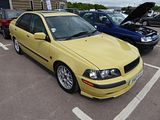
I have to conclude that this event was a bit of a disappointment. The other half of the car park was full to bursting, but that was because there was a Slot Car event taking place in the Museum. It meant that the marshalls, who seemed to have no interest in the Spring Classic event at all, started to direct cars over the Classic parking area. This had already included a line up of cars in the Disabled parking bays and the odd stray that was among the classics, giving the real impression that the Museum actually did not really care about the event that they had organised and (clearly, not very well) publicised, which was a real shame. If the same combination of events comes up on the equivalent weekend next year, I think I will be trying one of the other options.

